
Elementary Student Teaching (SAIC)

Beautiful Things
Kindergarteners work to create images from found objects.

Beautiful Things
Student work creating images out of found objects.

Exemplar of Circus Stunts 4th Grade Lesson
Students read the story Olivia Saves the Circus, written and illustrated by Ian Falconer, then imagined having to save the circus themselves and perform all of the acts using chalk pastels and charcoal for their illustrations.
This is my example where I chose to show a monkey juggling. I encouraged children to use examples from the book's illustrations, adding to or changing details to make it their own.

Circus Stunts!
Students read the story Olivia Saves the Circus, written and illustrated by Ian Falconer, then imagined having to save the circus themselves and perform all of the acts using chalk pastels and charcoal for their illustrations.

Circus Stunts!
Students read the story Olivia Saves the Circus, written and illustrated by Ian Falconer, then imagined having to save the circus themselves and perform all of the acts using chalk pastels and charcoal for their illustrations.

Students working on Circus Stunts

Student working on Circus Stunts

Paired Portraits
Photographer John Stezekar uses black and white images of celebrities from the golden era of Hollywood to compose Marriage portraits by slicing figures in half and juxtaposing each side by side to create a new narrative for the characters that are being portrayed.
His work was used as inspiration for a 7th grade lesson where students considered the composition of their work using two images from magazines to slice and overlay each creating a new public identity for their pieces. This explored the power of the media and how representations of public figures create narratives that are sometimes true and sometimes false.

Detail of exemplars of Paired Portraits
My pieces explored the portrayal of men and women in public advertisements.

Detail of exemplars of Paired Portraits

Students working on Paired Portraits
Students had a set amount of time to leaf through magazines and choose images to juxtapose. They then worked to arrange and glue images in a way where figures and faces aligned to create a new narrative.

Students working on Paired Portraits
Students had a set amount of time to leaf through magazines and choose images to juxtapose. They then worked to arrange and glue images in a way where figures and faces aligned to create a new narrative.

Student example of Paired Portrait

Postcard places: personal portraits in pastel
1st and 2nd grade lesson spread.

Postcard places: personal places in pastel
1st and 2nd grade lesson spread.

A student works on a sketch handout to design their postcard.

A student works on a sketch handout to design their postcard.

A student works on a sketch handout to design their postcard.

A student sketch of their postcard design.




Final student postcard.
Oil pastel on paper
3.5" x 5"

Final student postcard.
Oil pastel on paper
3.5" x 5"

Final student postcard.
Oil pastel on paper
3.5" x 5"

1st grade students worked on their tracing, cutting, and collage skills to create their very own busy bees that are collecting pollen from their large colorful flower drawings.
I walked students through each step shown here, reinforcing vocabulary and checking for understanding before moving on to the next step. This provides the basic parts of the bee, where students are responsible for adding legs, pollen, and a stinger!
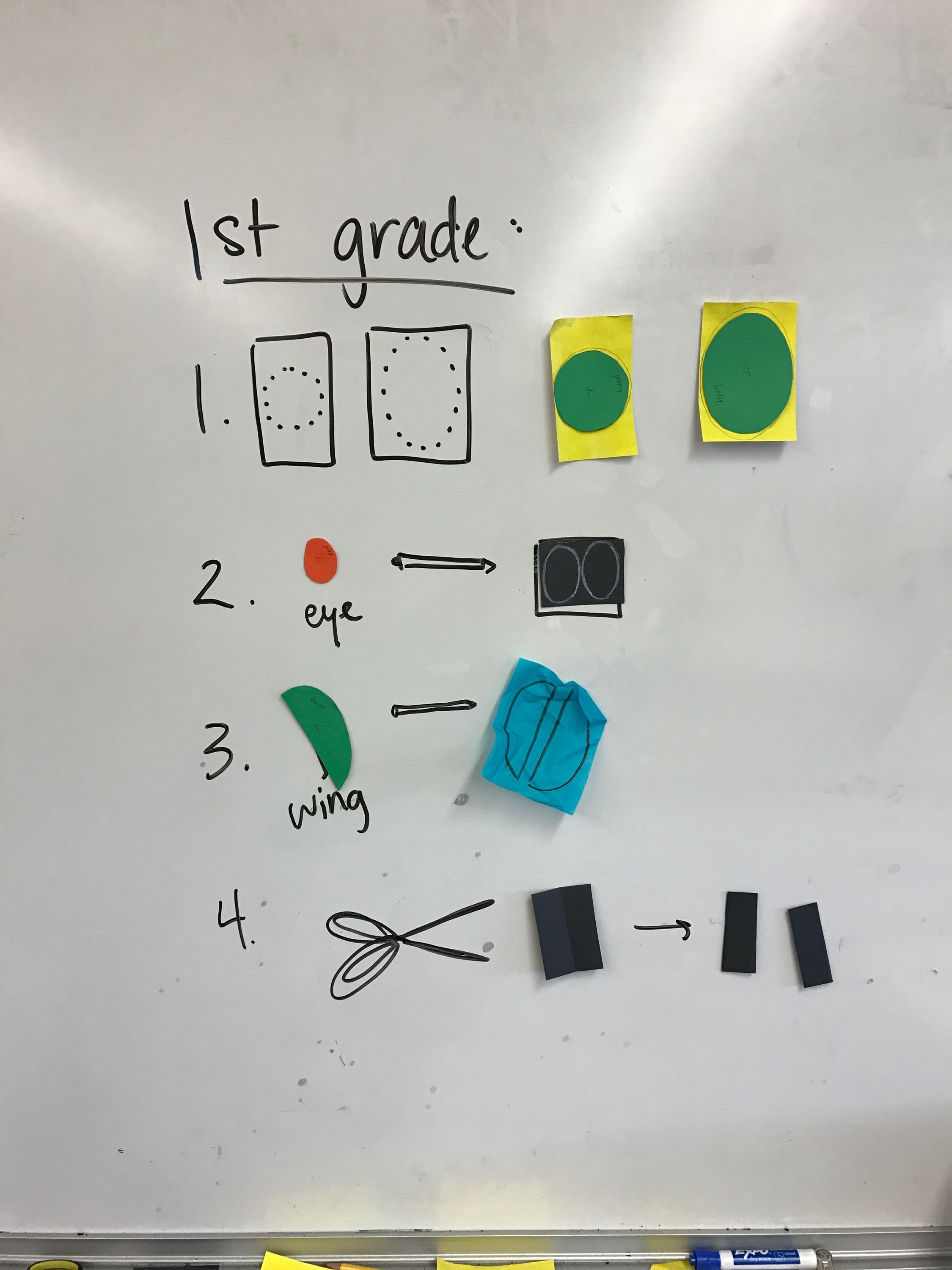
Busy bees step-by-step
1st grade students worked on their tracing, cutting, and collage skills to create their very own busy bees that are collecting pollen from their large colorful flower drawings.
I walked students through each step shown here, reinforcing vocabulary and checking for understanding before moving on to the next step. This provides the basic parts of the bee, where students are responsible for adding legs, pollen, and a stinger!
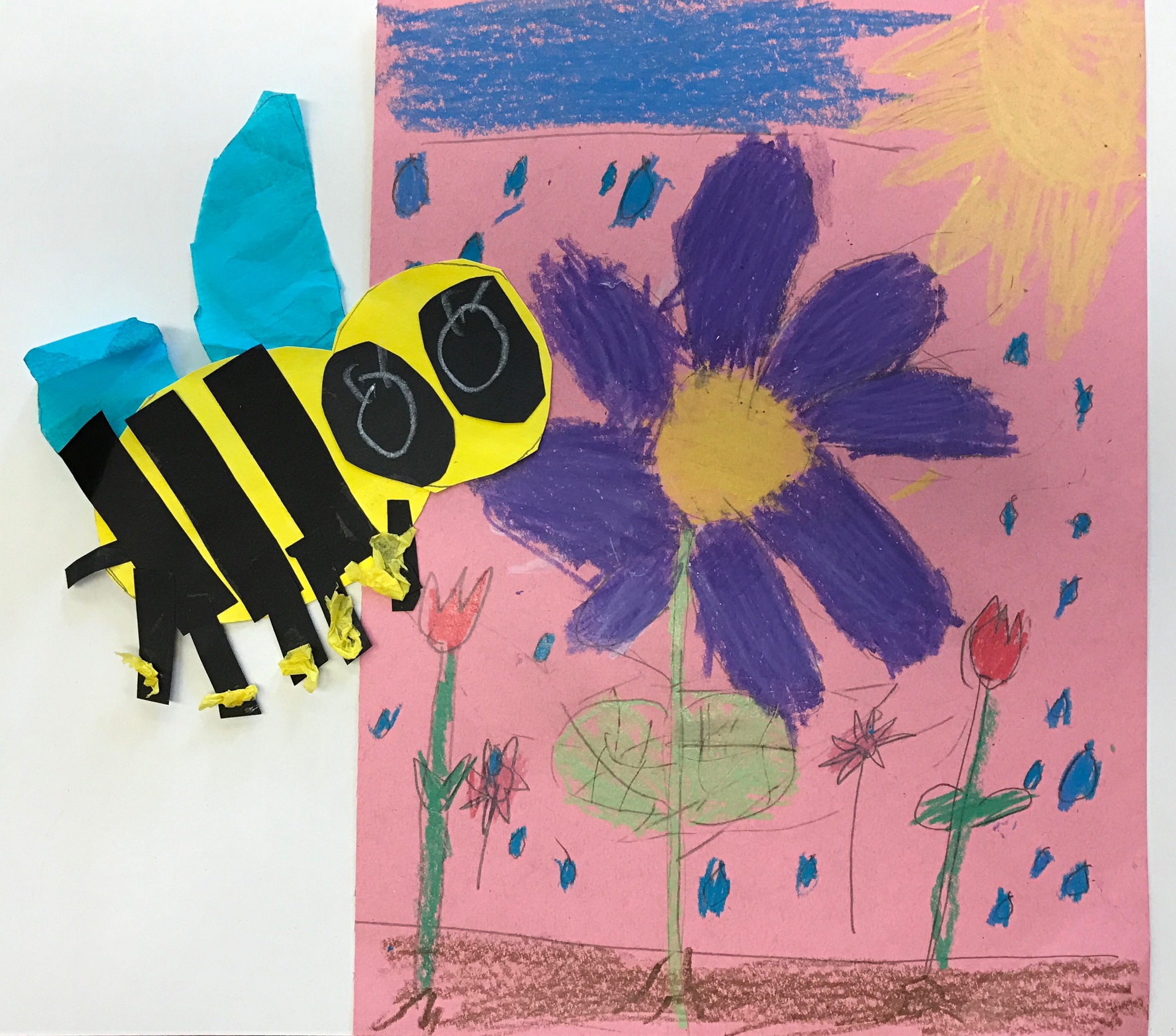
Busy Bees
1st grade students showed how important bees are for our planet through blending colors and creating pattern on large flower drawings, to cutting, constructing and collaging bees with pollen on their legs.
Construction crayons on construction paper, painted papers, tissue paper
paper measures 9" x 12"
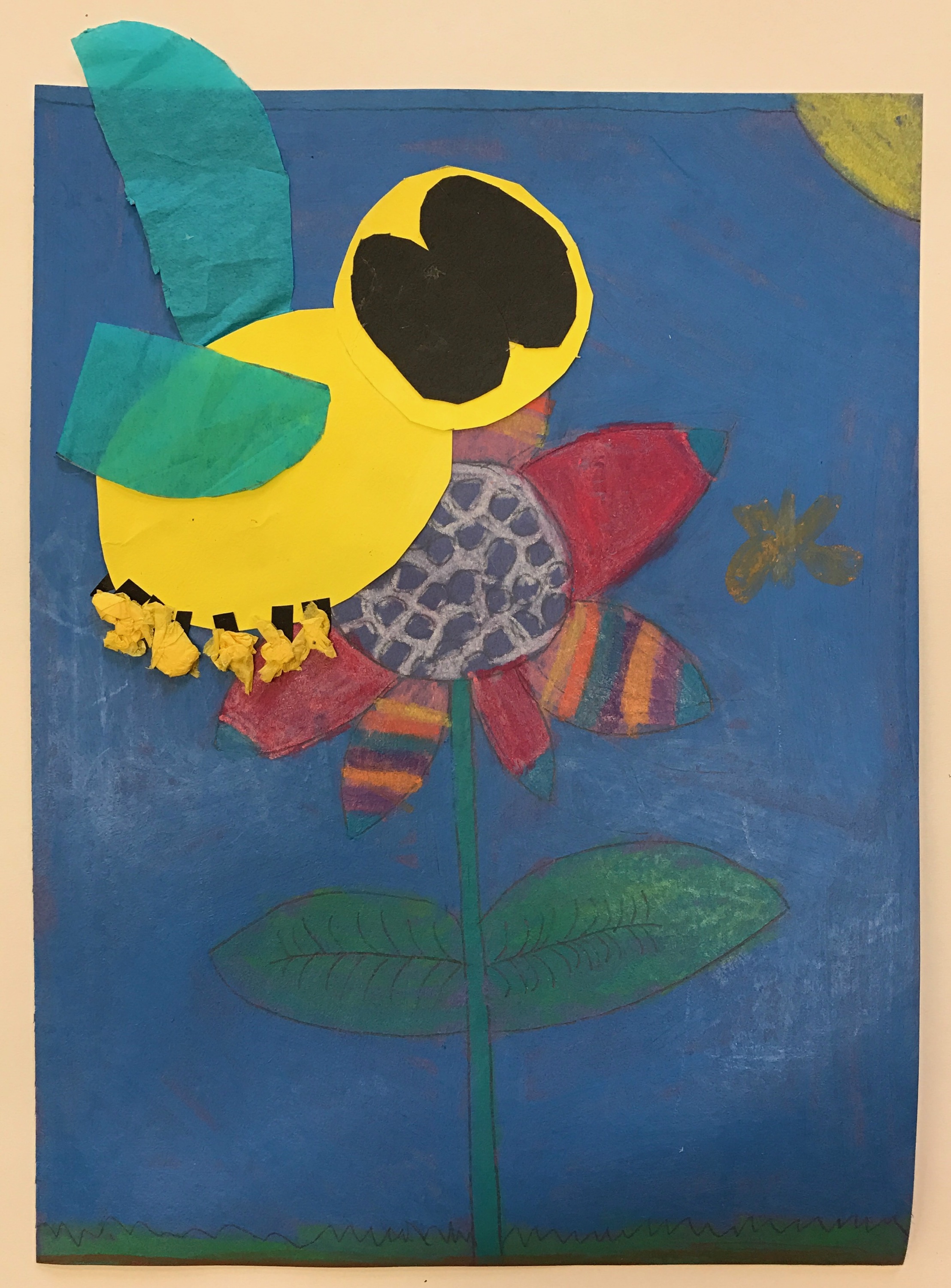
Busy Bees
1st grade students showed how important bees are for our planet through blending colors and creating pattern on large flower drawings, to cutting, constructing and collaging bees with pollen on their legs.
Construction crayons on construction paper, painted papers, tissue paper
paper measures 9" x 12"
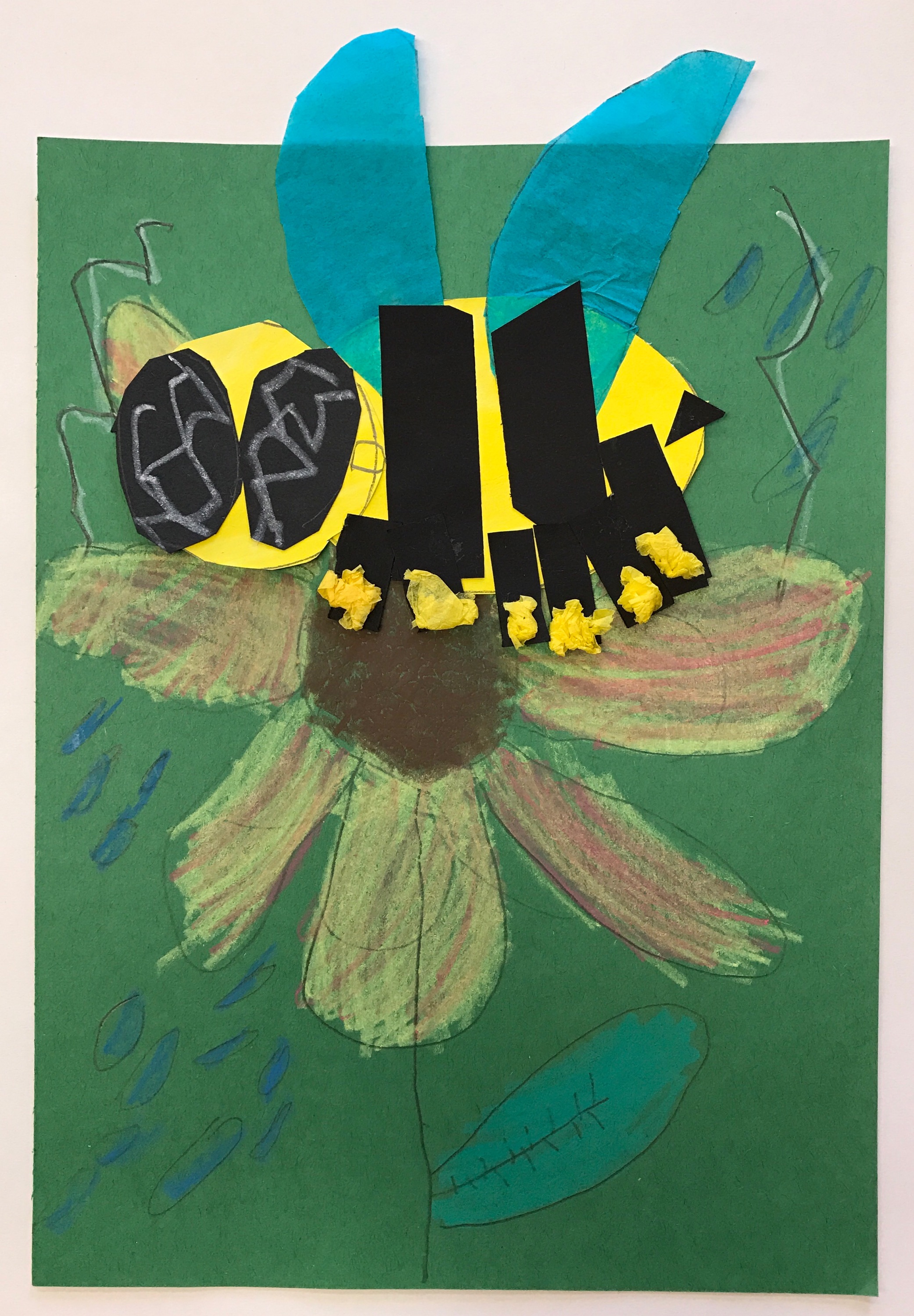
Busy Bees
1st grade students showed how important bees are for our planet through blending colors and creating pattern on large flower drawings, to cutting, constructing and collaging bees with pollen on their legs.
Construction crayons on construction paper, painted papers, tissue paper
paper measures 9" x 12"

Busy Bees
1st grade students showed how important bees are for our planet through blending colors and creating pattern on large flower drawings, to cutting, constructing and collaging bees with pollen on their legs.
Construction crayons on construction paper, painted papers, tissue paper
paper measures 9" x 12"

Busy Bees
1st grade students showed how important bees are for our planet through blending colors and creating pattern on large flower drawings, to cutting, constructing and collaging bees with pollen on their legs.
Construction crayons on construction paper, painted papers, tissue paper
paper measures 9" x 12"
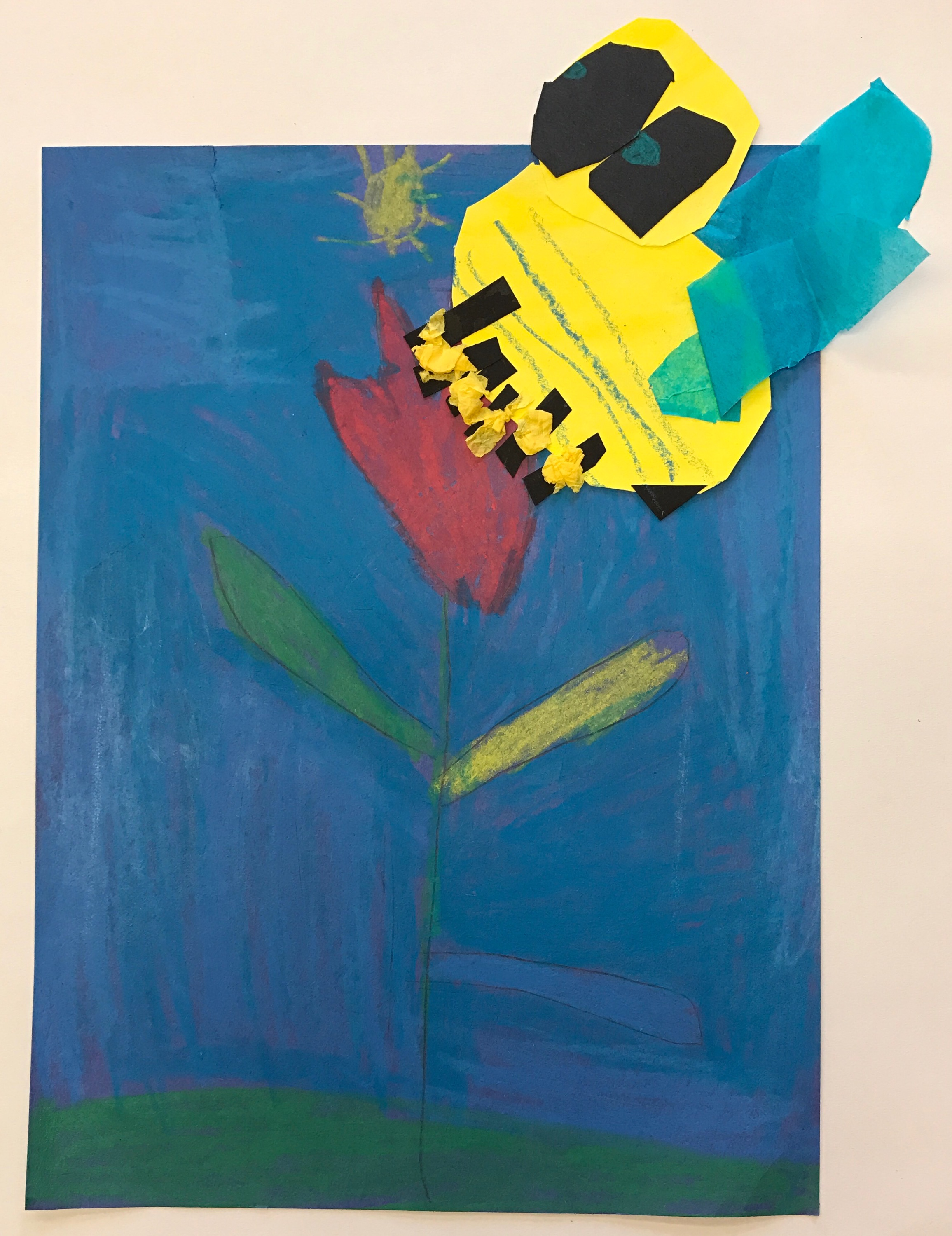
Busy Bees
1st grade students showed how important bees are for our planet through blending colors and creating pattern on large flower drawings, to cutting, constructing and collaging bees with pollen on their legs.
Construction crayons on construction paper, painted papers, tissue paper
paper measures 9" x 12"

Busy Bees
1st grade students showed how important bees are for our planet through blending colors and creating pattern on large flower drawings, to cutting, constructing and collaging bees with pollen on their legs.
Construction crayons on construction paper, painted papers, tissue paper
paper measures 9" x 12"
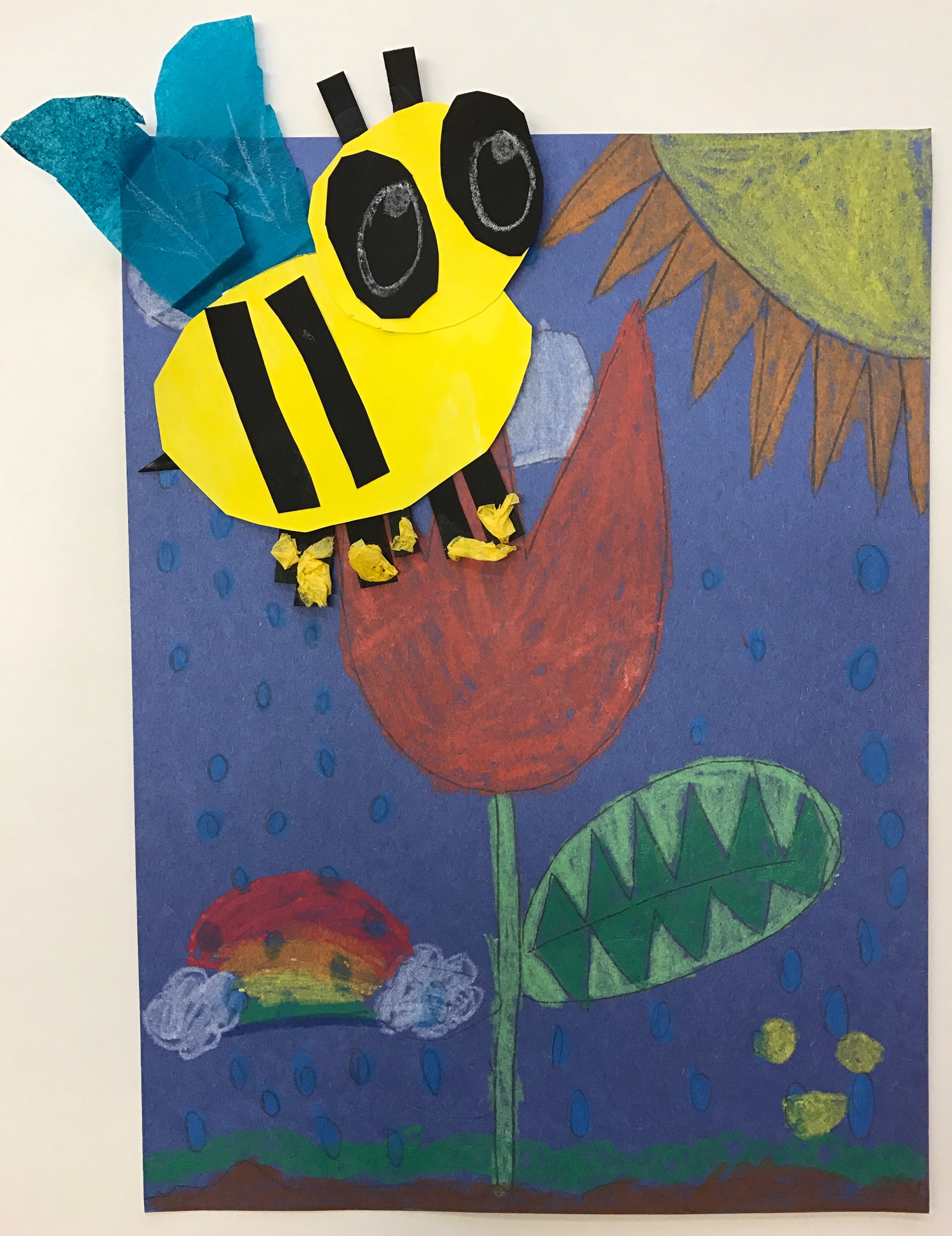
Busy Bees
1st grade students showed how important bees are for our planet through blending colors and creating pattern on large flower drawings, to cutting, constructing and collaging bees with pollen on their legs.
Construction crayons on construction paper, painted papers, tissue paper
paper measures 9" x 12"

Busy Bees
1st grade students showed how important bees are for our planet through blending colors and creating pattern on large flower drawings, to cutting, constructing and collaging bees with pollen on their legs.
Construction crayons on construction paper, painted papers, tissue paper
paper measures 9" x 12"
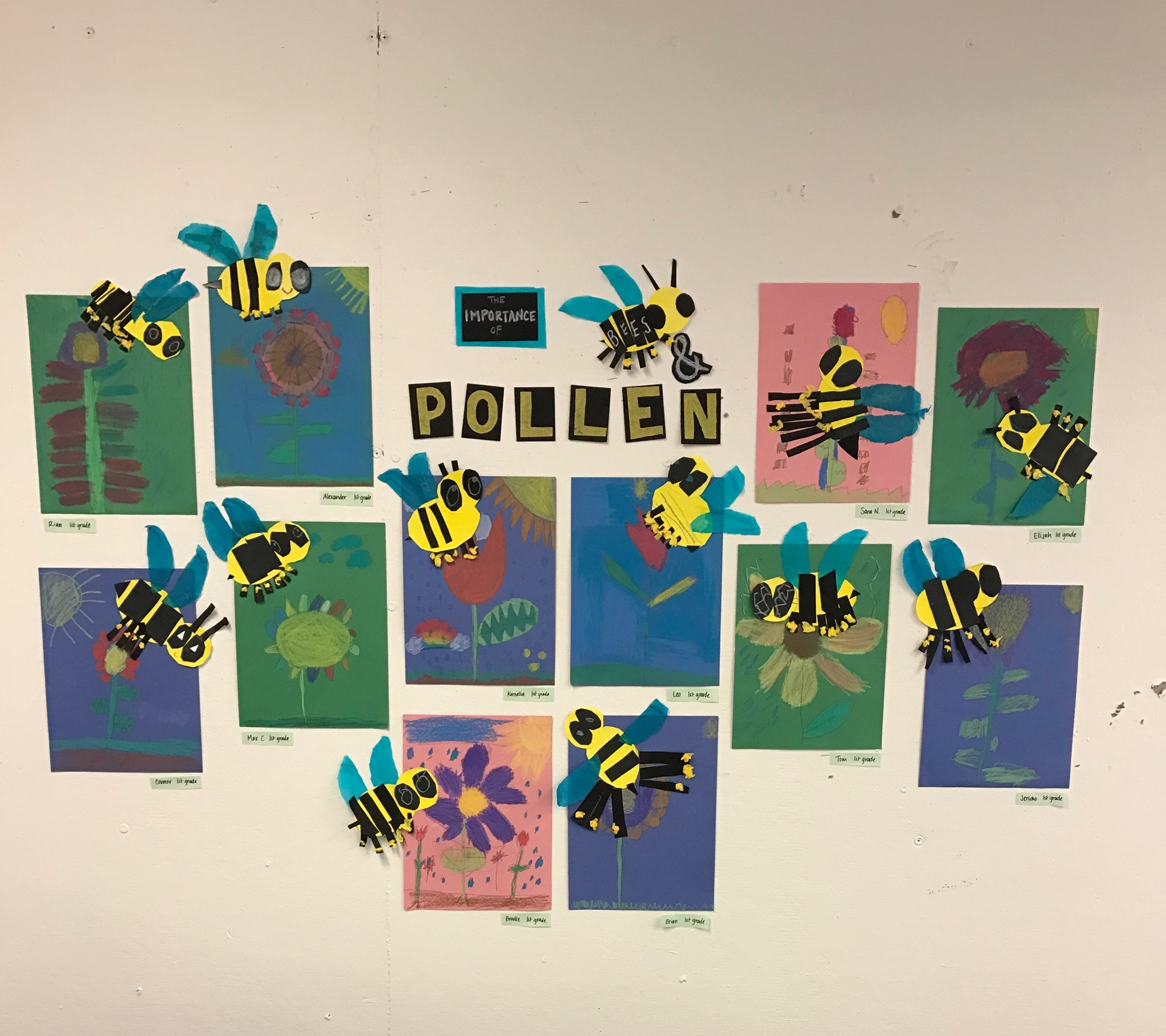
Installation of 1st grade work.
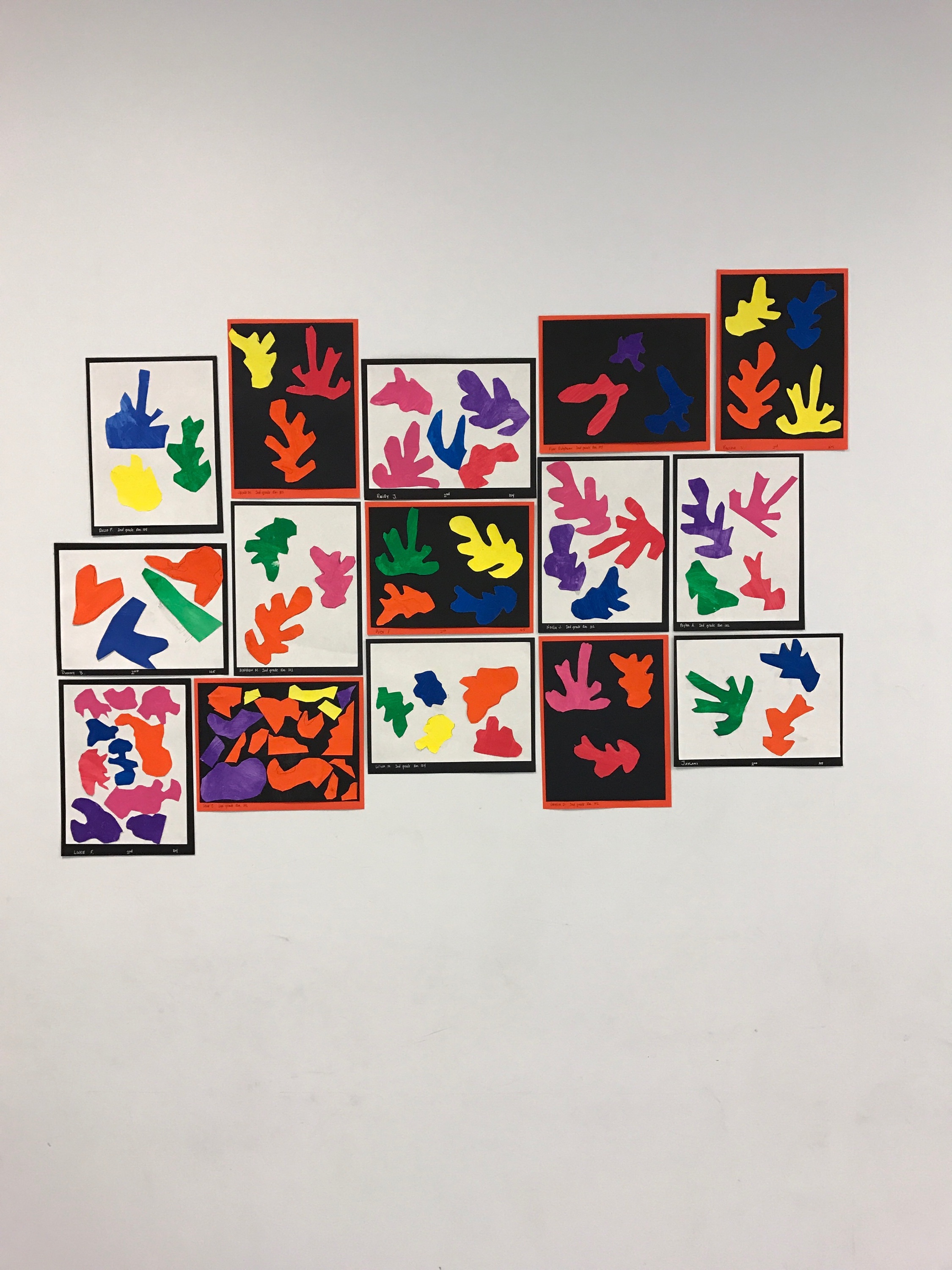
Henri Matisse cutouts installation
2nd grade students practiced their organic shape drawing skills, emulating the process of artist Henri Matisse. Students first painted large pieces of paper just like Matisse, before cutting out their very own shapes and arranging them on a white or black paper ground making sure to not overlap their shapes and include lots of colors.
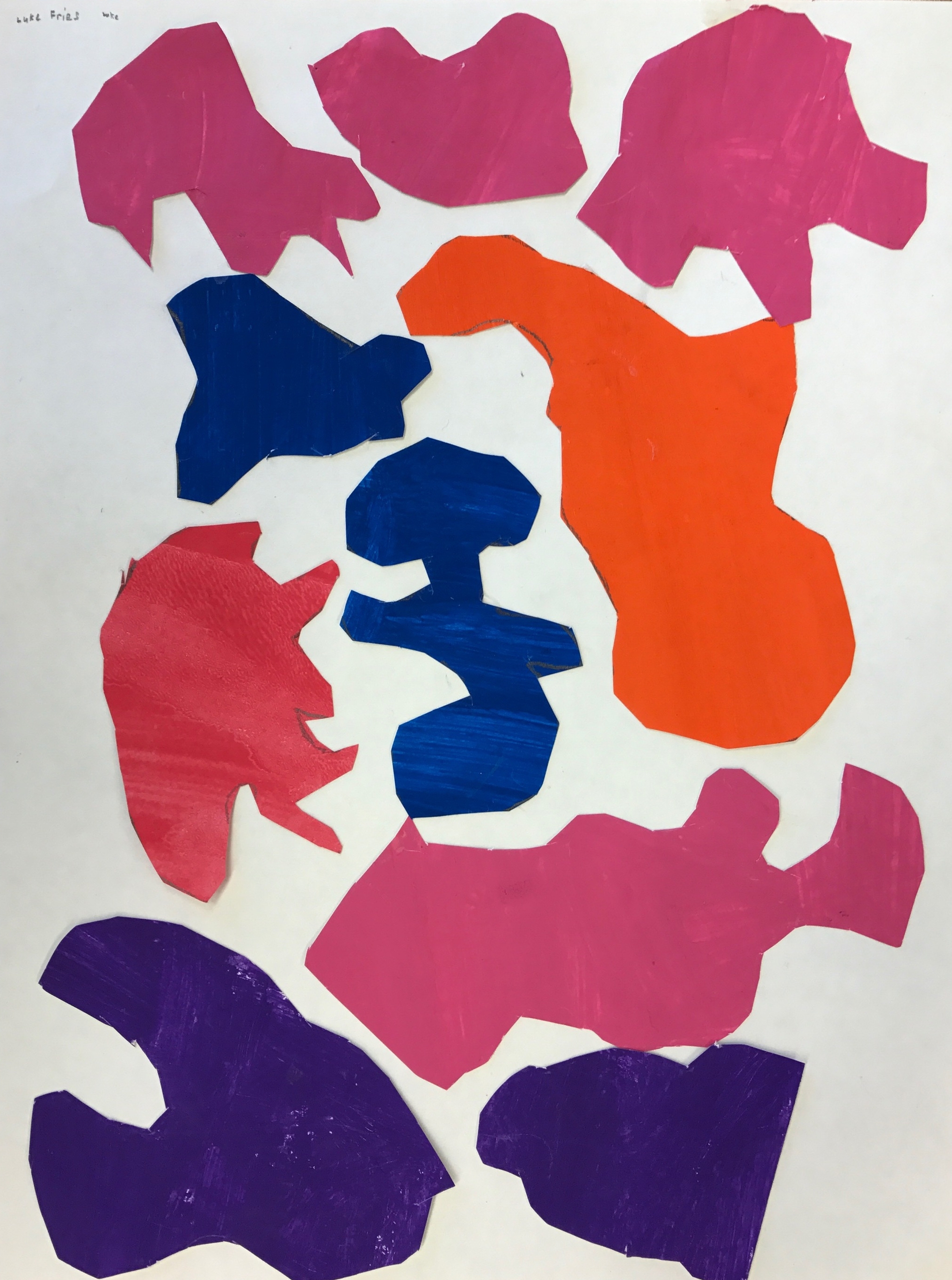
Henri Matisse cutouts
2nd grade students practiced their organic shape drawing skills, emulating the process of artist Henri Matisse. Students first painted large pieces of paper just like Matisse, before cutting out their very own shapes and arranging them on a white or black paper ground making sure to not overlap their shapes and include lots of colors.
Collaged papers
9" x 12"

Henri Matisse cutouts
2nd grade students practiced their organic shape drawing skills, emulating the process of artist Henri Matisse. Students first painted large pieces of paper just like Matisse, before cutting out their very own shapes and arranging them on a white or black paper ground making sure to not overlap their shapes and include lots of colors.
Collaged papers
9" x 12"
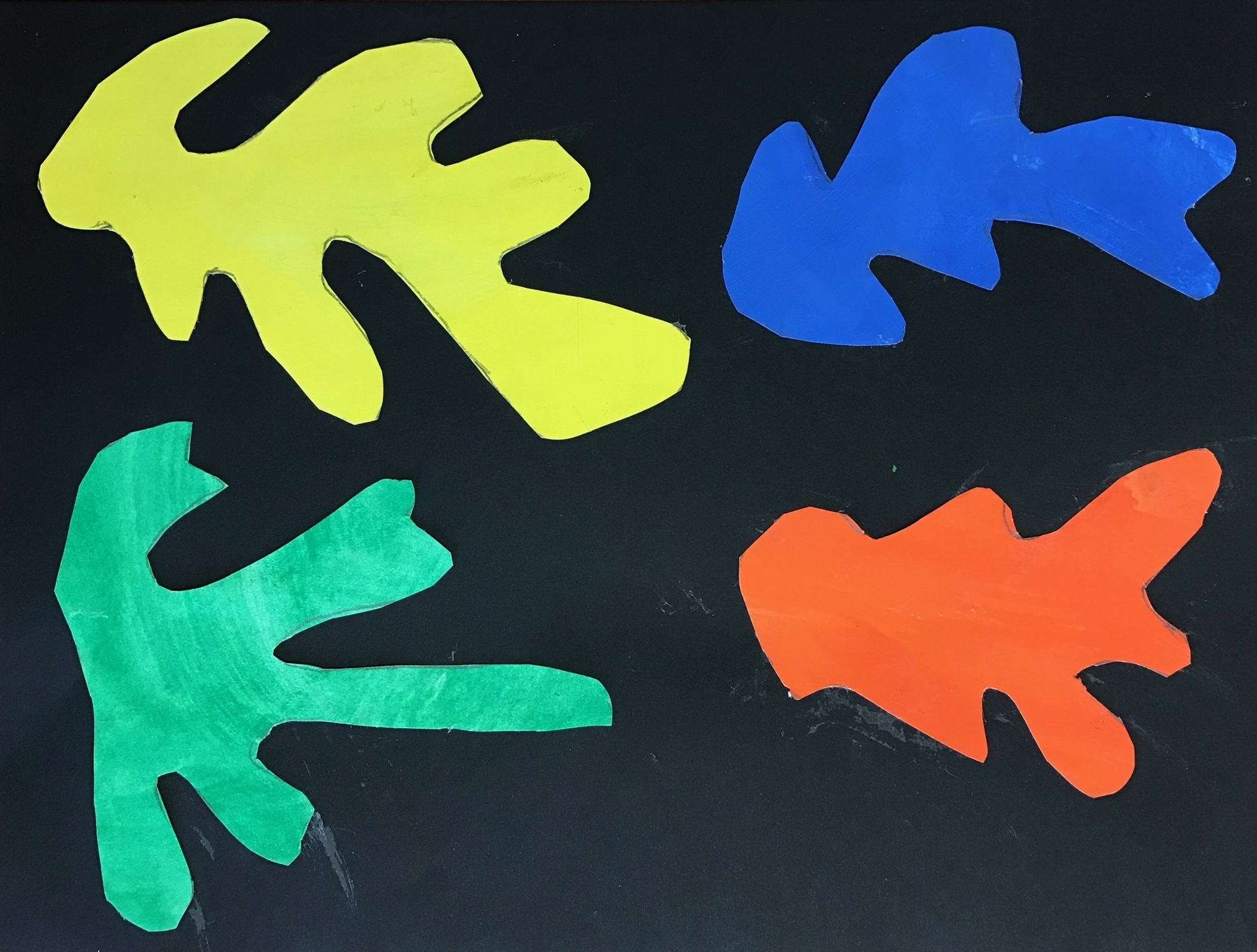
Henri Matisse cutouts
2nd grade students practiced their organic shape drawing skills, emulating the process of artist Henri Matisse. Students first painted large pieces of paper just like Matisse, before cutting out their very own shapes and arranging them on a white or black paper ground making sure to not overlap their shapes and include lots of colors.
Collaged papers
9" x 12"
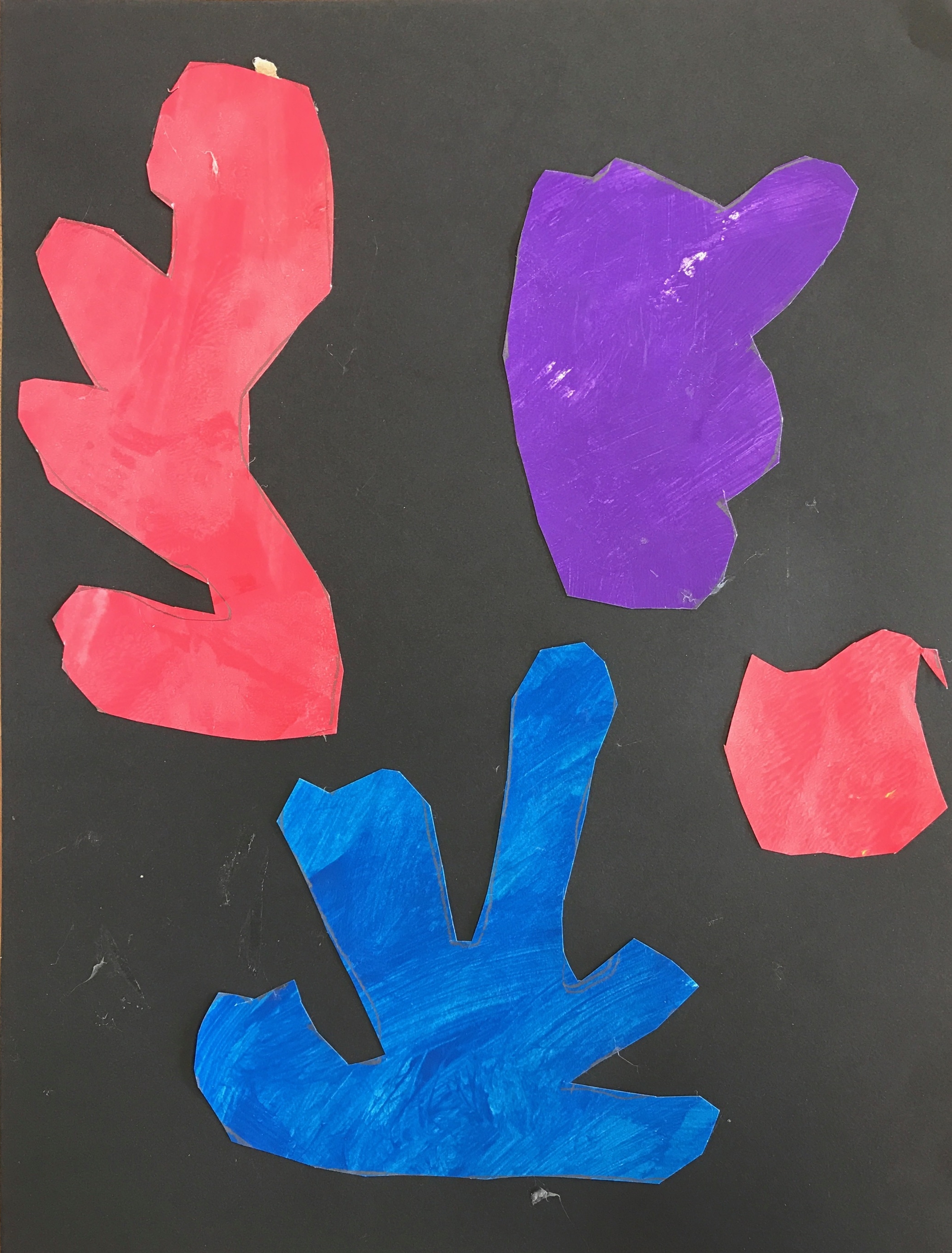
Henri Matisse cutouts
2nd grade students practiced their organic shape drawing skills, emulating the process of artist Henri Matisse. Students first painted large pieces of paper just like Matisse, before cutting out their very own shapes and arranging them on a white or black paper ground making sure to not overlap their shapes and include lots of colors.
Collaged papers
9" x 12"
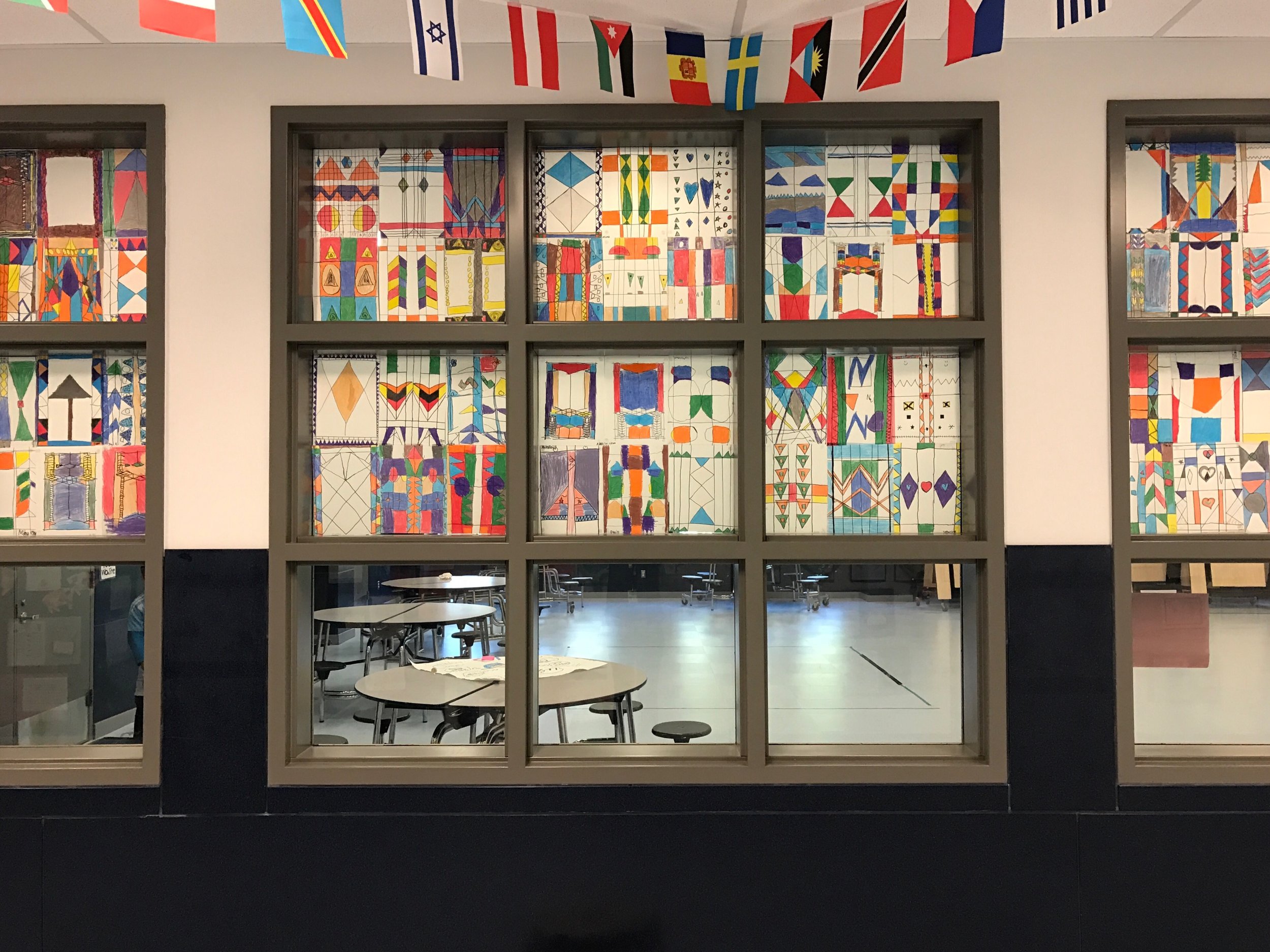
Installation of 3rd grade Frank Lloyd Wright windows in the school's cafeteria.
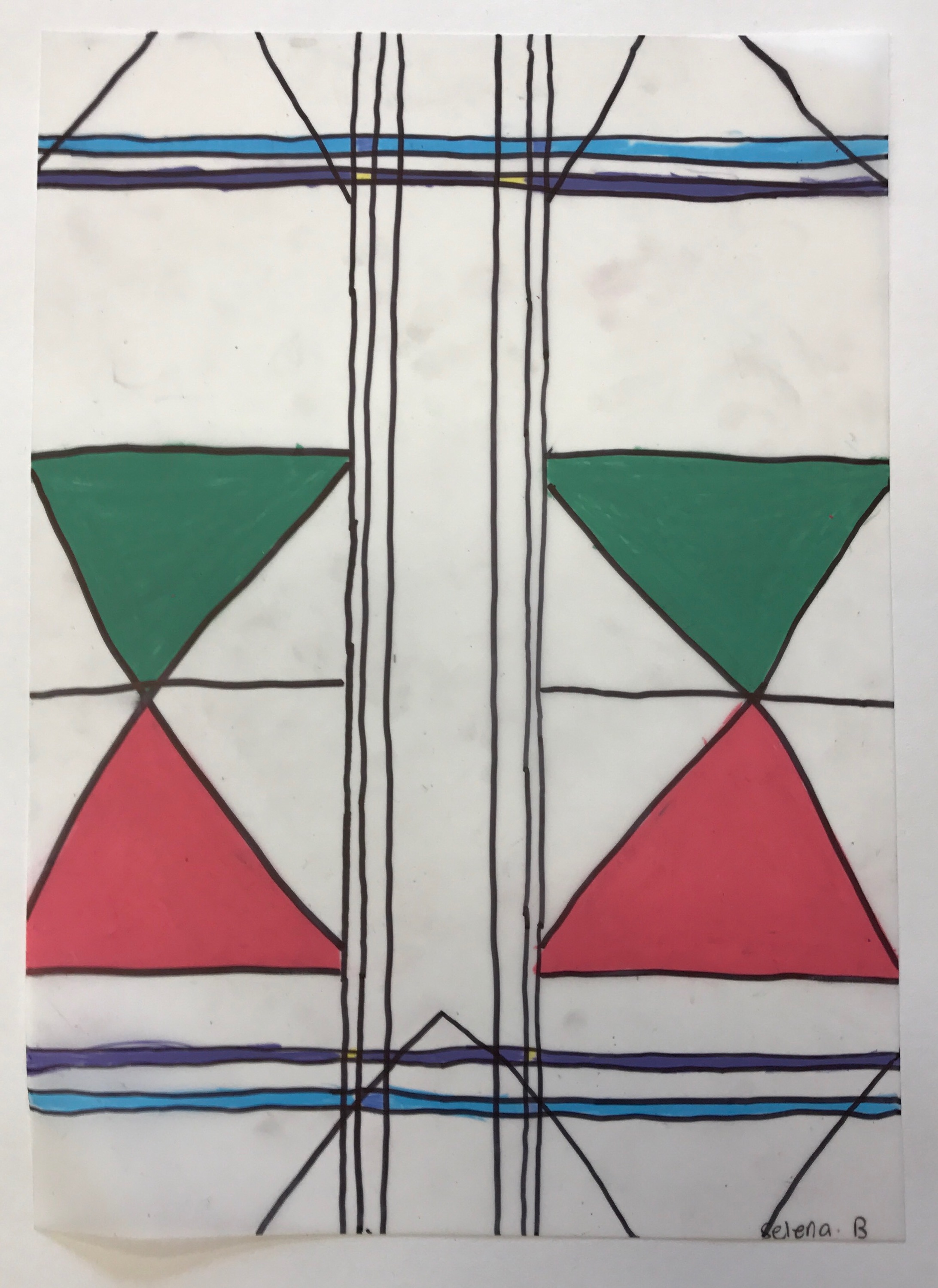
Frank Lloyd Wright stained glass windows
3rd grade students explored local artists in Chicago and were surprised to learn that Frank Lloyd Wright not only was an architect that designed houses, he also designed stained glass windows!
Students learned how to use symmetry with line and color to create their own window designs for display in their school cafeteria windows.
Sharpie, color sticks on vellum
9" x 12"
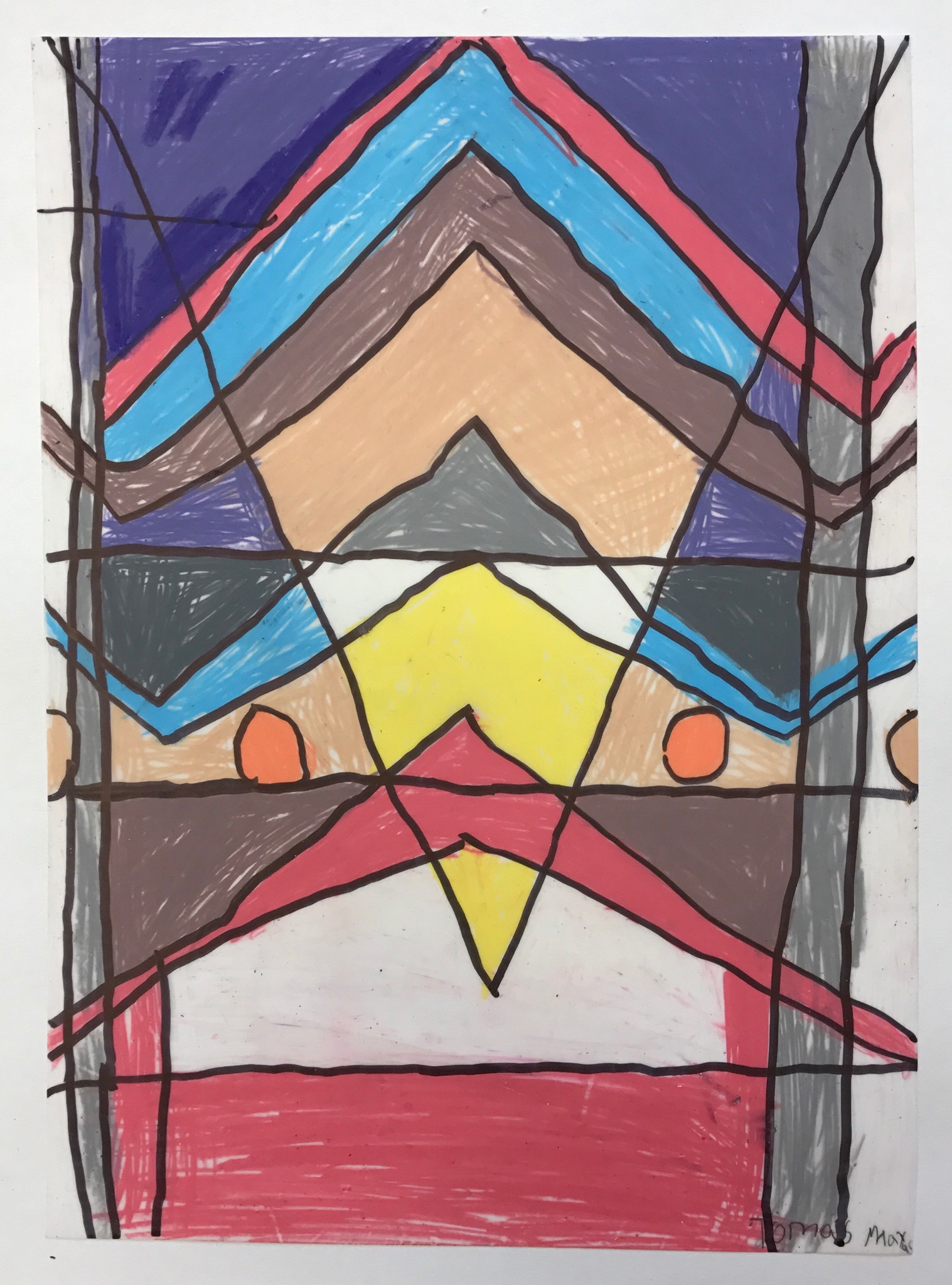
Frank Lloyd Wright stained glass windows
3rd grade students explored local artists in Chicago and were surprised to learn that Frank Lloyd Wright not only was an architect that designed houses, he also designed stained glass windows!
Students learned how to use symmetry with line and color to create their own window designs for display in their school cafeteria windows.
Sharpie, color sticks on vellum
9" x 12"
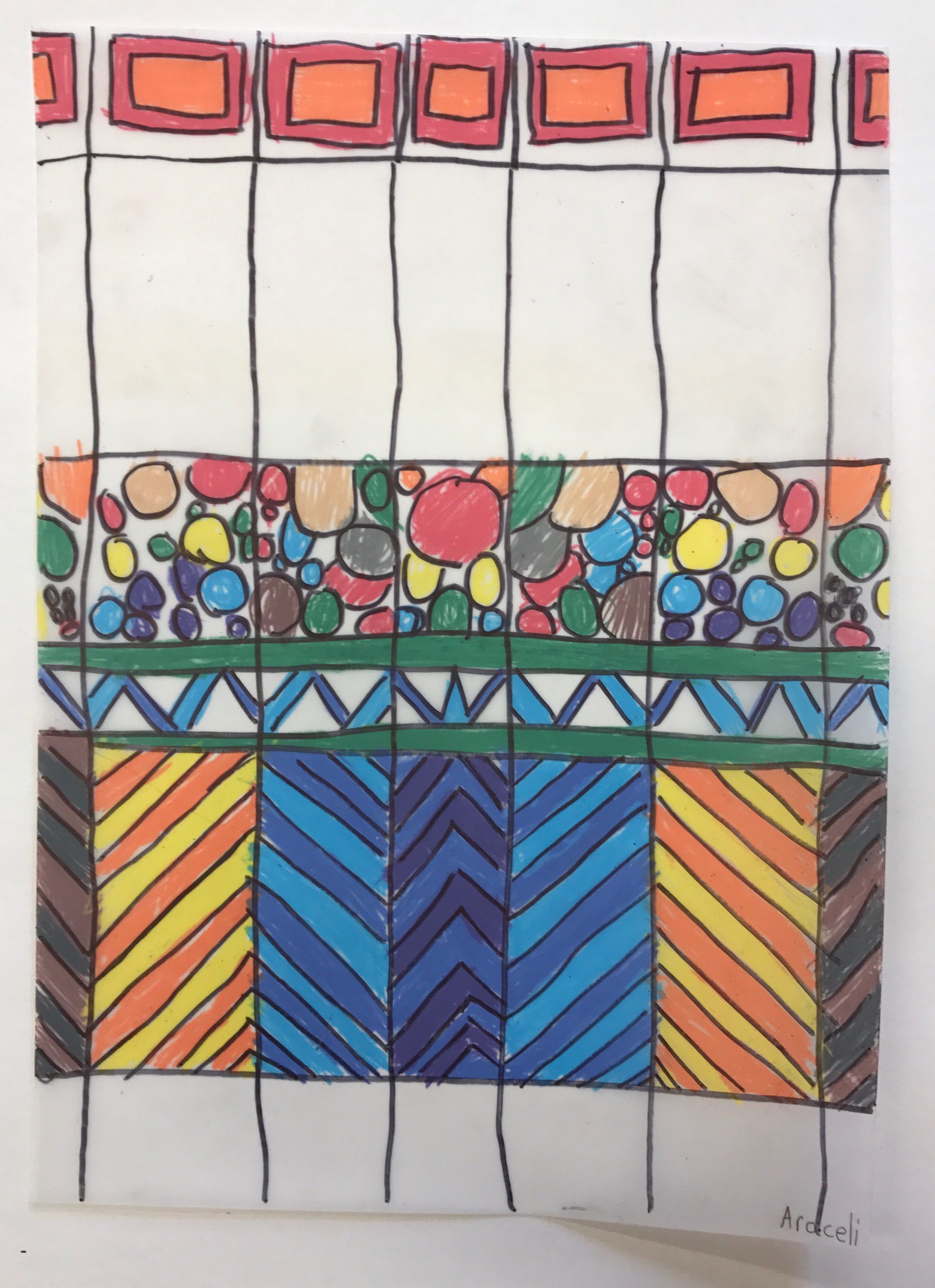
Frank Lloyd Wright stained glass windows
3rd grade students explored local artists in Chicago and were surprised to learn that Frank Lloyd Wright not only was an architect that designed houses, he also designed stained glass windows!
Students learned how to use symmetry with line and color to create their own window designs for display in their school cafeteria windows.
Sharpie, color sticks on vellum
9" x 12"
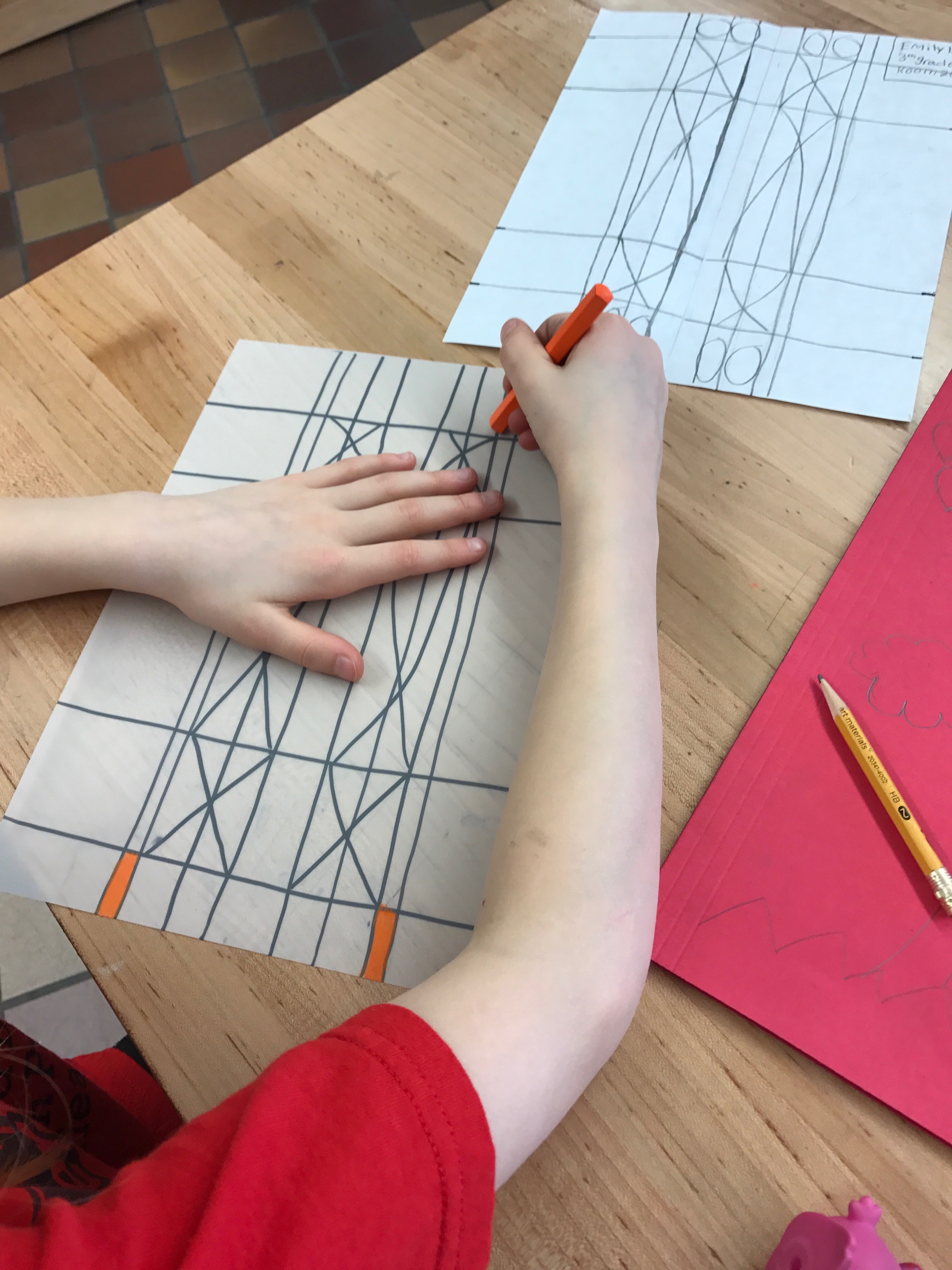
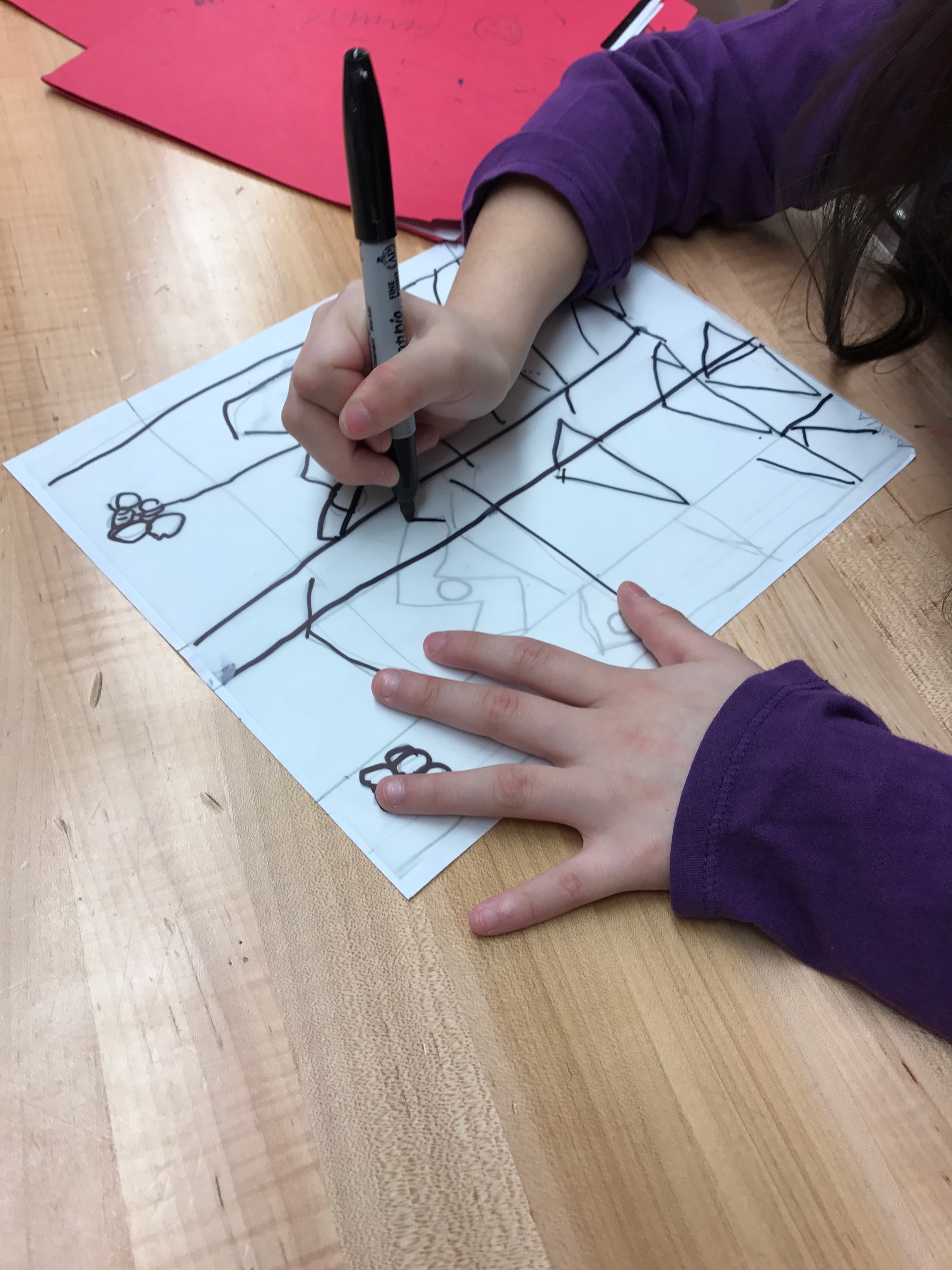


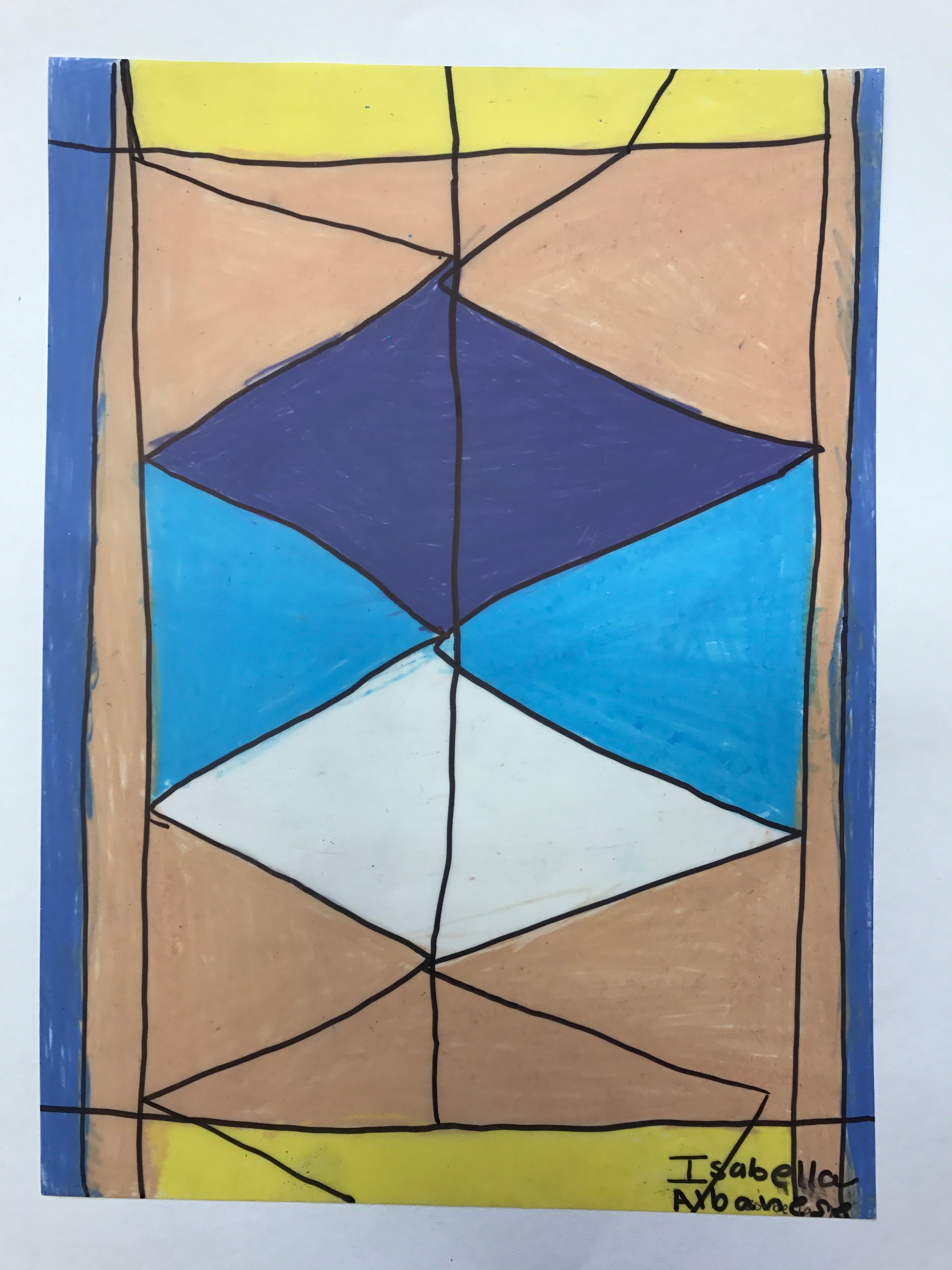
Frank Lloyd Wright stained glass windows
3rd grade students explored local artists in Chicago and were surprised to learn that Frank Lloyd Wright not only was an architect that designed houses, he also designed stained glass windows!
Students learned how to use symmetry with line and color to create their own window designs for display in their school cafeteria windows.
Sharpie, color sticks on vellum
9" x 12"
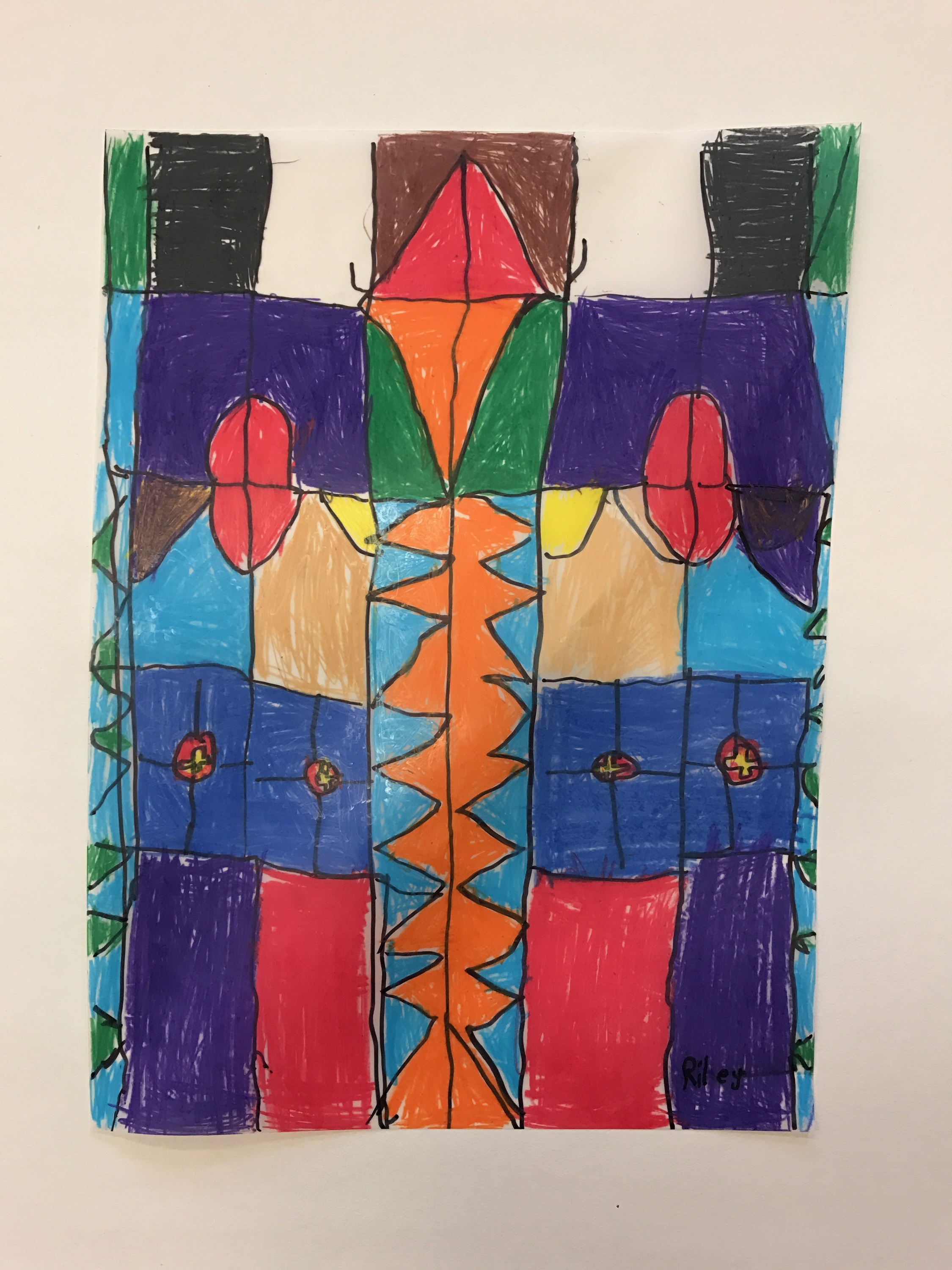
Frank Lloyd Wright stained glass windows
3rd grade students explored local artists in Chicago and were surprised to learn that Frank Lloyd Wright not only was an architect that designed houses, he also designed stained glass windows!
Students learned how to use symmetry with line and color to create their own window designs for display in their school cafeteria windows.
Sharpie, color sticks on vellum
9" x 12"
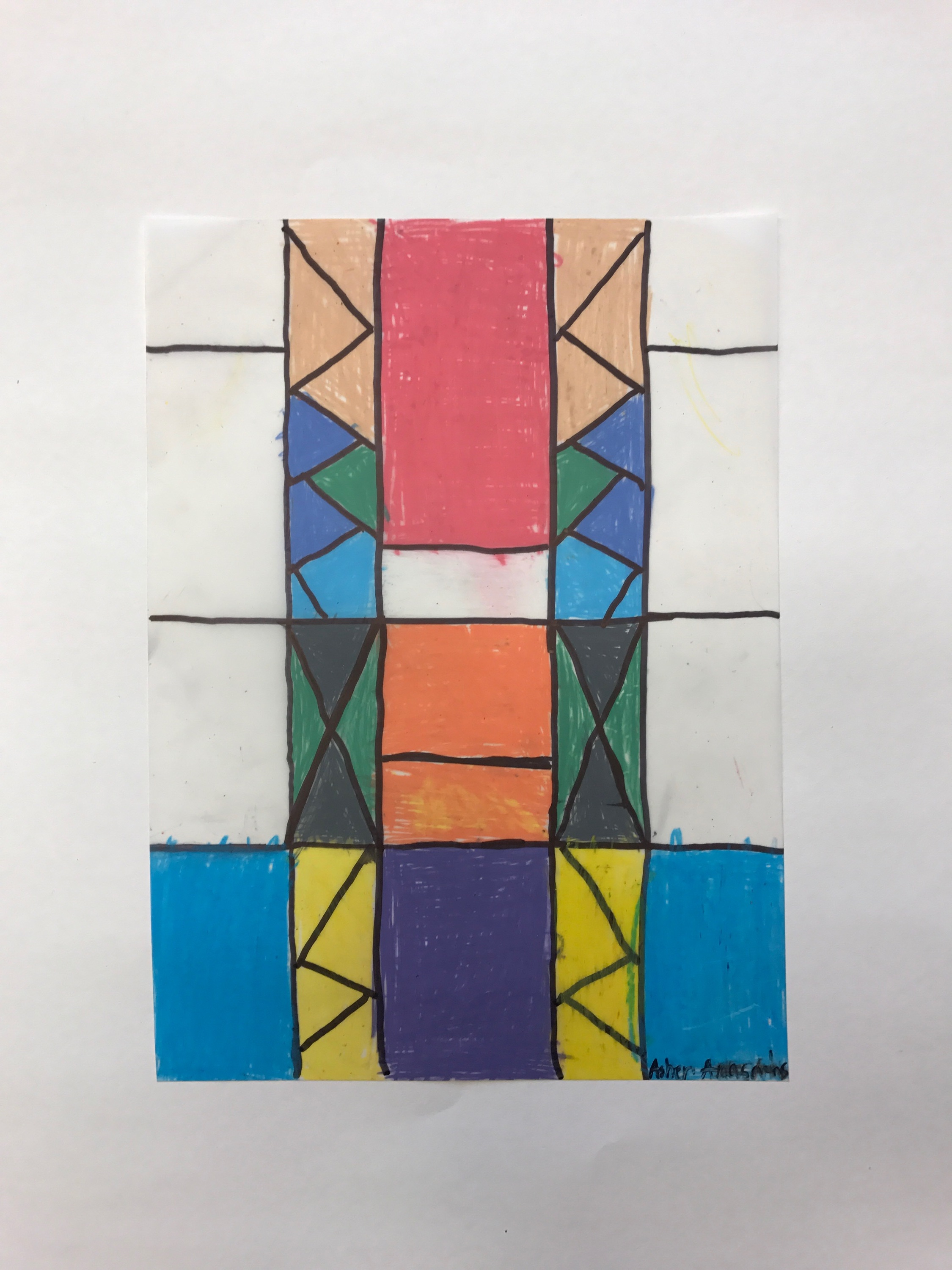
Frank Lloyd Wright stained glass windows
3rd grade students explored local artists in Chicago and were surprised to learn that Frank Lloyd Wright not only was an architect that designed houses, he also designed stained glass windows!
Students learned how to use symmetry with line and color to create their own window designs for display in their school cafeteria windows.
Sharpie, color sticks on vellum
9" x 12"

Frank Lloyd Wright stained glass windows
3rd grade students explored local artists in Chicago and were surprised to learn that Frank Lloyd Wright not only was an architect that designed houses, he also designed stained glass windows!
Students learned how to use symmetry with line and color to create their own window designs for display in their school cafeteria windows.
Sharpie, color sticks on vellum
9" x 12"
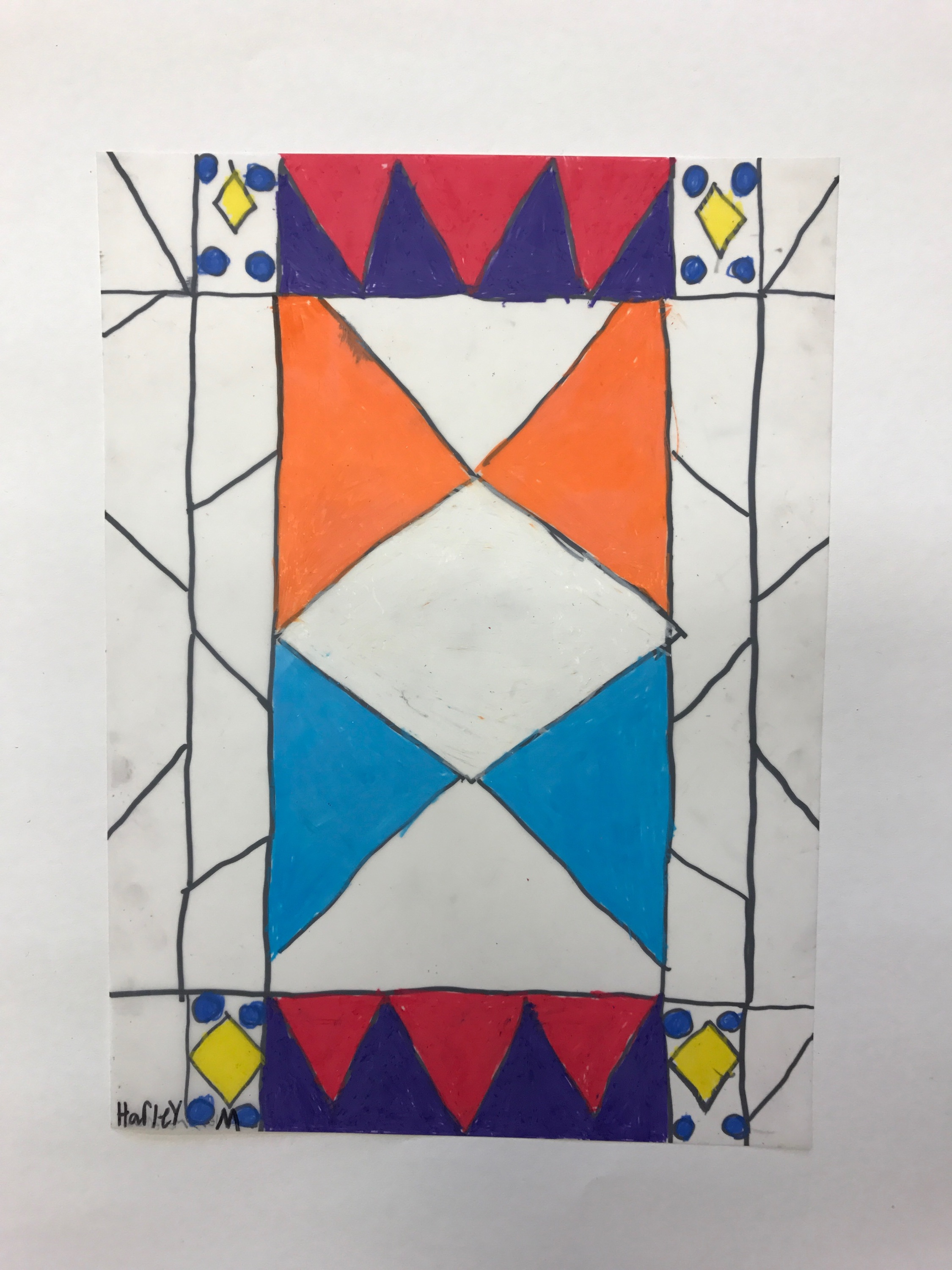
Frank Lloyd Wright stained glass windows
3rd grade students explored local artists in Chicago and were surprised to learn that Frank Lloyd Wright not only was an architect that designed houses, he also designed stained glass windows!
Students learned how to use symmetry with line and color to create their own window designs for display in their school cafeteria windows.
Sharpie, color sticks on vellum
9" x 12"

4th grade students learned all about inference and worked to develop and design their very own comics using special col-erase pencils, sharpies, and colored pencils.
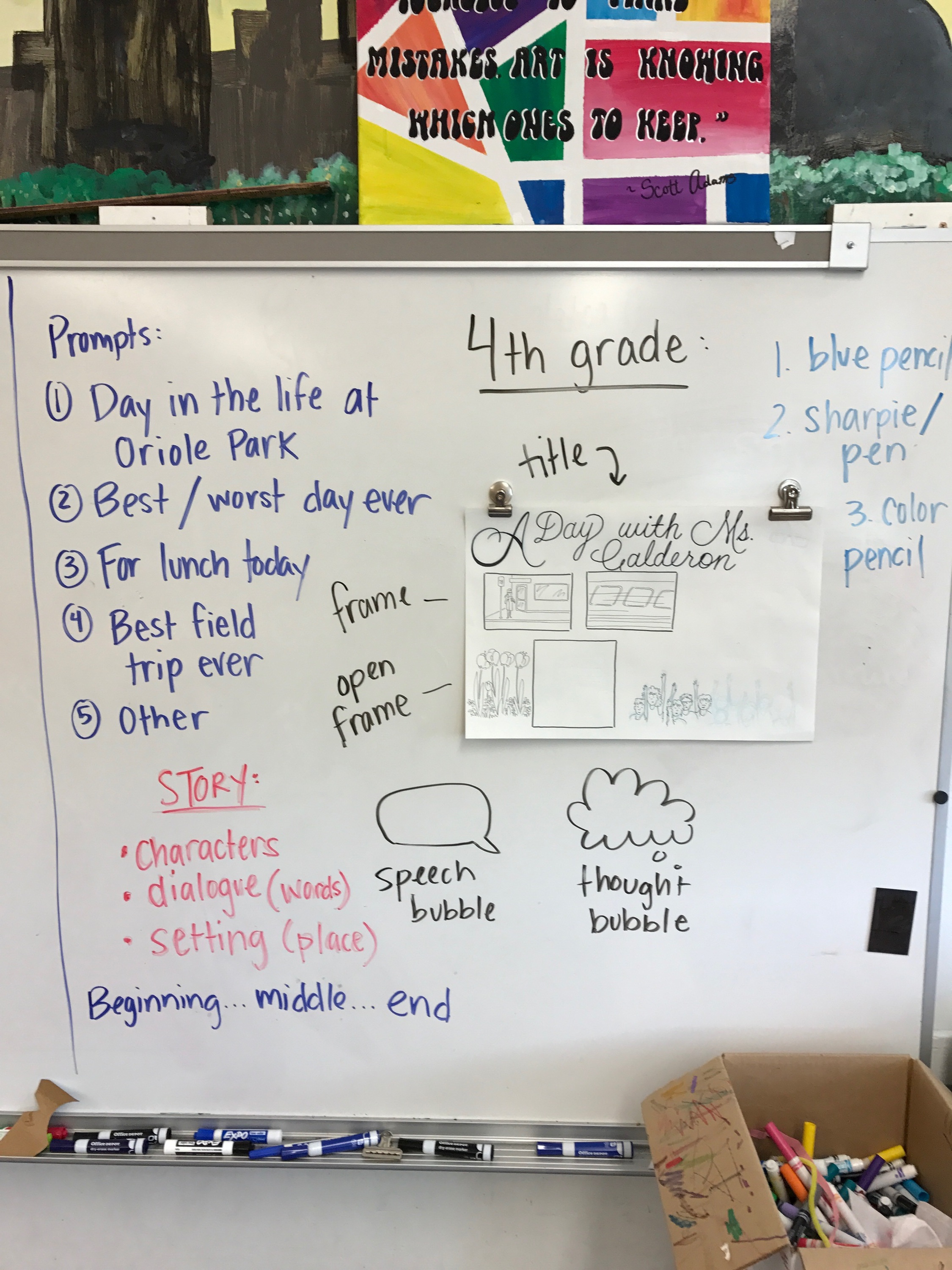
Written and illustrated instructions to support students as they work to design and create their own comics. My exemplar shows several steps in this process, first using the blue col-erase pencils to draw their comics, then using the sharpie and a thin pen to add in detail.
Students then have the option to color their comics using colored pencils.

Inferring comics
4th grade students learned all about inference and worked to develop and design their very own comics.
Col-erase pencils, sharpies, and colored pencils
18" x 12"

Inferring comics
4th grade students learned all about inference and worked to develop and design their very own comics.
Col-erase pencils, sharpies, and colored pencils
18" x 12"

Inferring comics
4th grade students learned all about inference and worked to develop and design their very own comics.
Col-erase pencils, sharpies, and colored pencils
18" x 12"

Inferring comics
4th grade students learned all about inference and worked to develop and design their very own comics.
Col-erase pencils, sharpies, and colored pencils
18" x 12"

Inferring comics
4th grade students learned all about inference and worked to develop and design their very own comics.
Col-erase pencils, sharpies, and colored pencils
18" x 12"

Inferring comics
4th grade students learned all about inference and worked to develop and design their very own comics.
Col-erase pencils, sharpies, and colored pencils
18" x 12"

6th grade students worked alongside their social studies curriculum to research, design, and construct a contemporary counterpart to traditional Inca civilization deity masks.
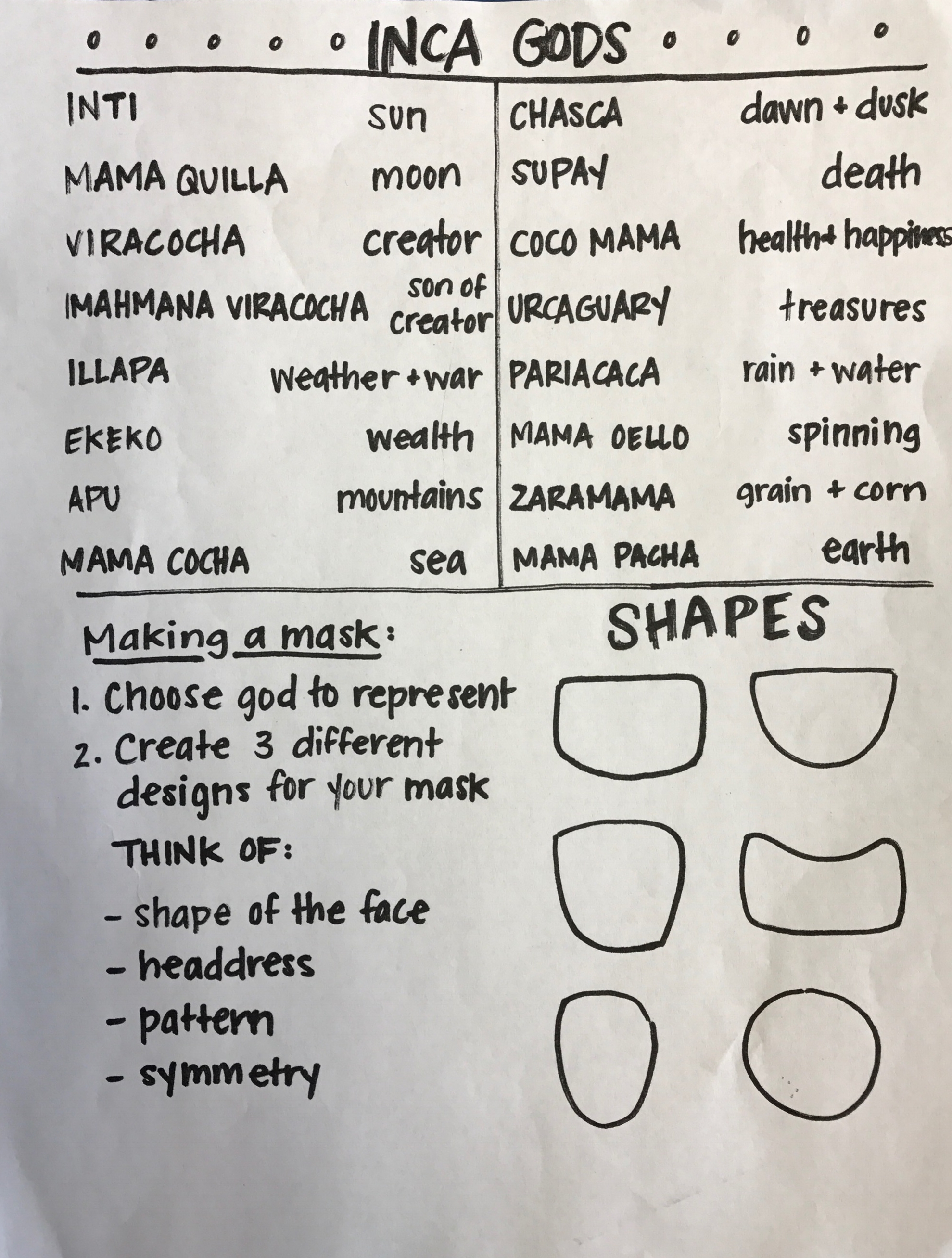
Support with list of Inca gods for students to reference, as well as initial steps in designing their masks. I also provided face shape and smaller templates to aid in drawing symmetric designs.
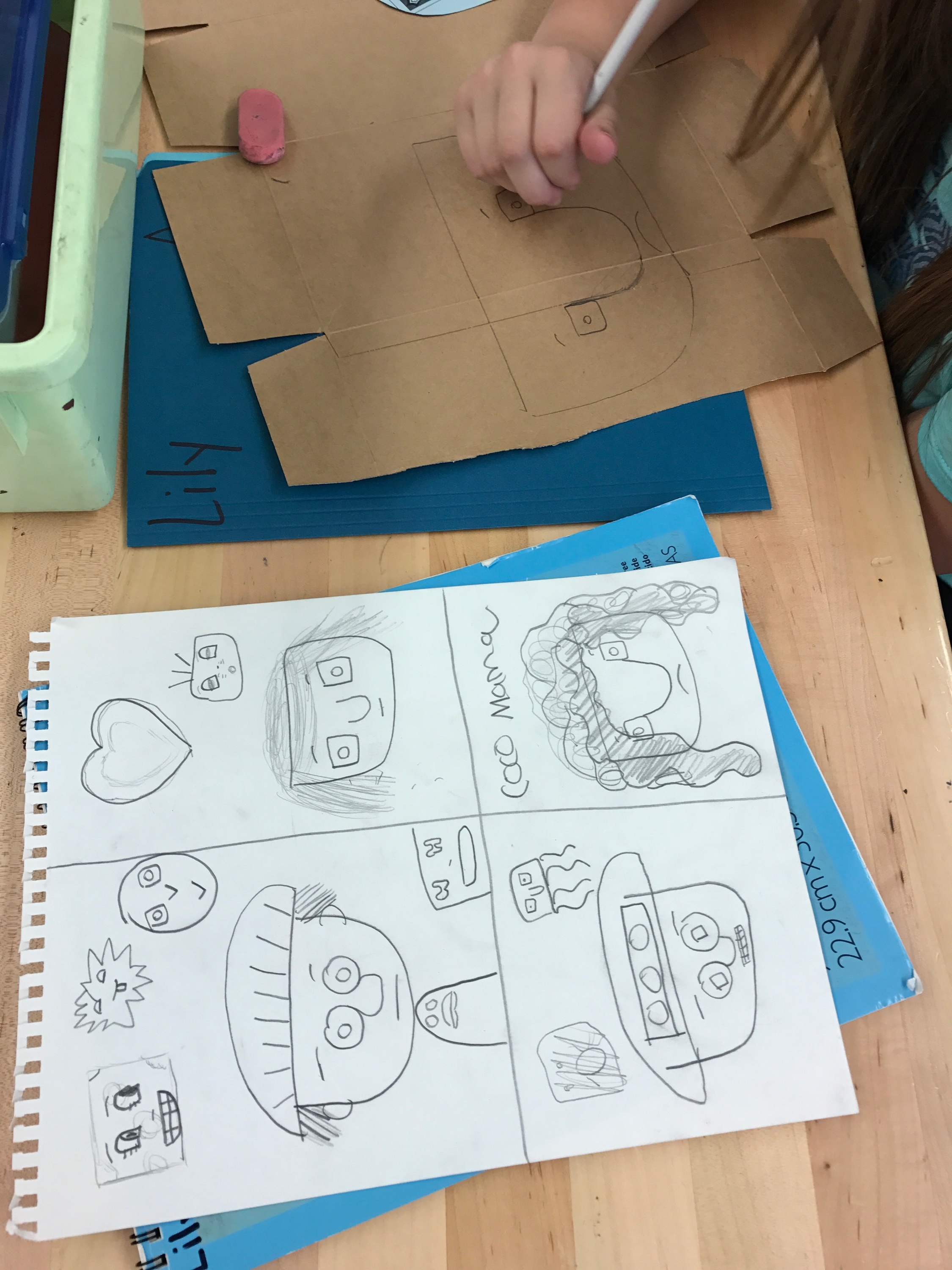
Student working from initial sketches to begin planning to construct their mask from cardboard.
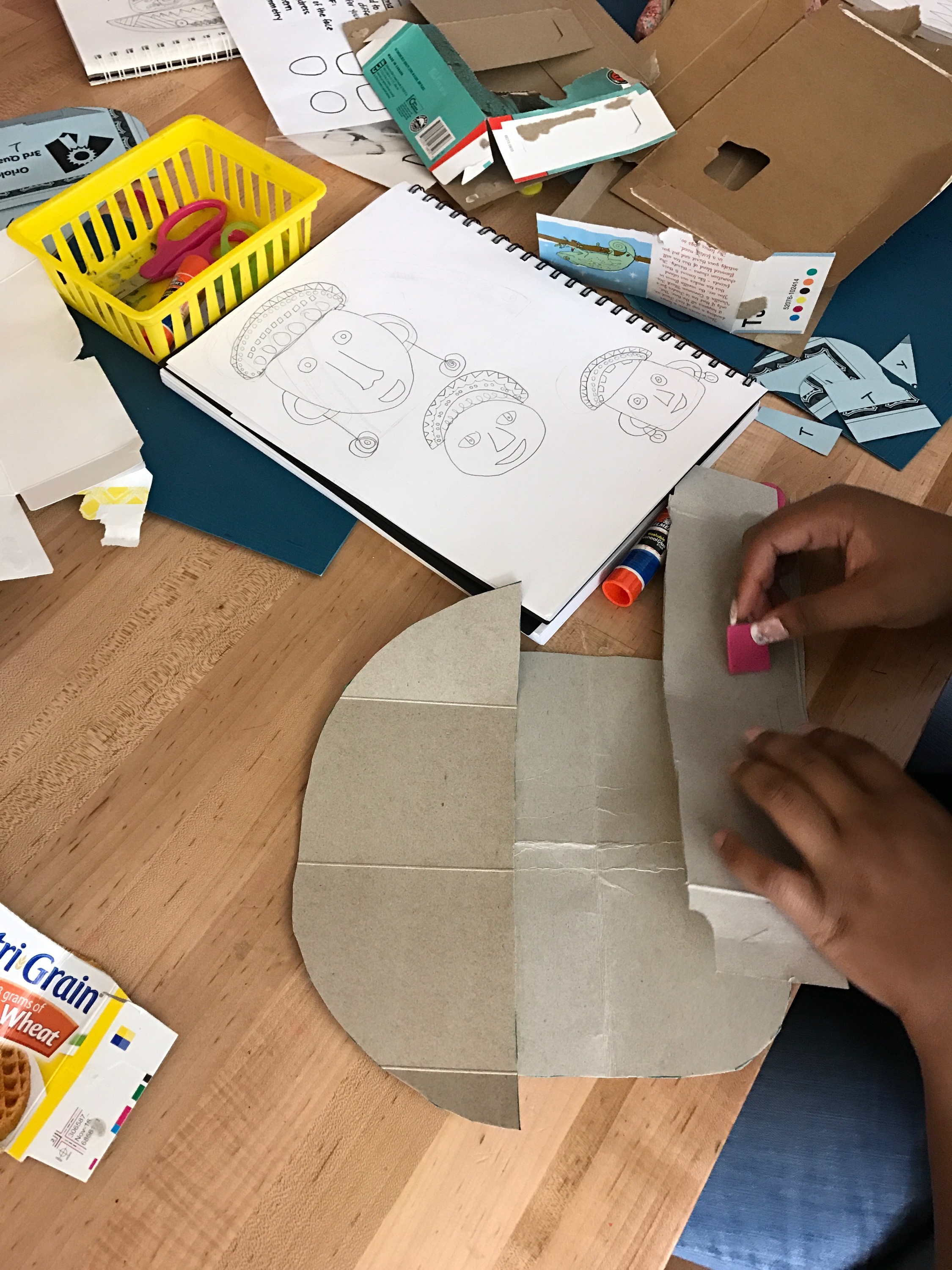
Student constructing mask by layering cardboard.
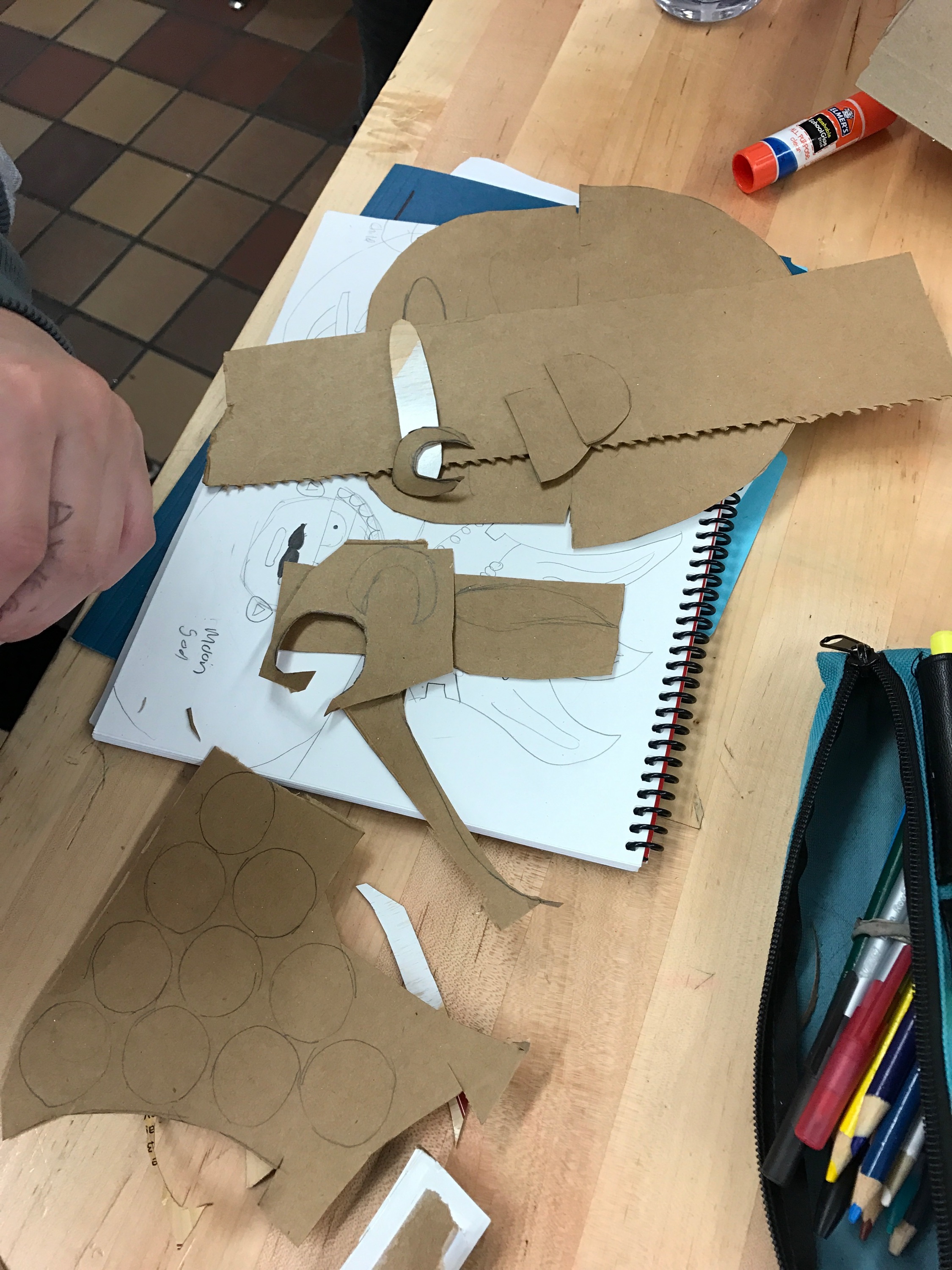
Student constructing mask.
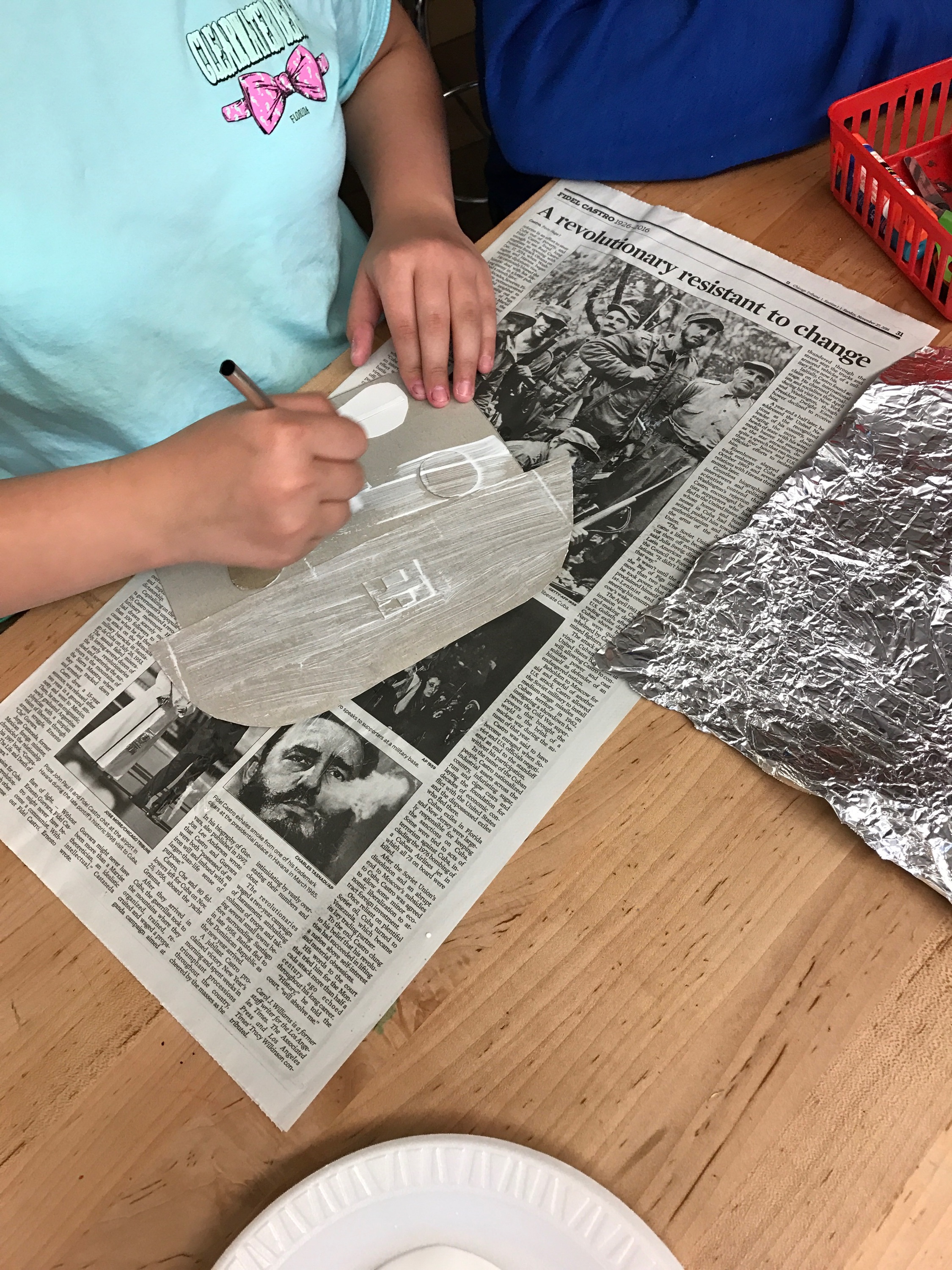
Student applying mod podge to constructed mask before applying a layer of aluminum foil to the surface.

Contemporary Inca masks installation
6th grade students worked alongside their social studies curriculum to research, design, and construct a contemporary counterpart to traditional Inca civilization deity masks.
Construction paper, aluminum foil, acrylic paint, ink
average size: 10" x 10"

Contemporary Inca masks installation
6th grade students worked alongside their social studies curriculum to research, design, and construct a contemporary counterpart to traditional Inca civilization deity masks.
Construction paper, aluminum foil, acrylic paint, ink
average size: 10" x 10"

2 Day Tinkercad
7th grade students worked with the online 3D design platform Tinkercad to create their own prototype to be 3D printed. Pictured here are the options students were given for form, in addition to size limitations to consider perspective and scale, as well as specifications to learn the program and practice spacial reasoning skills.
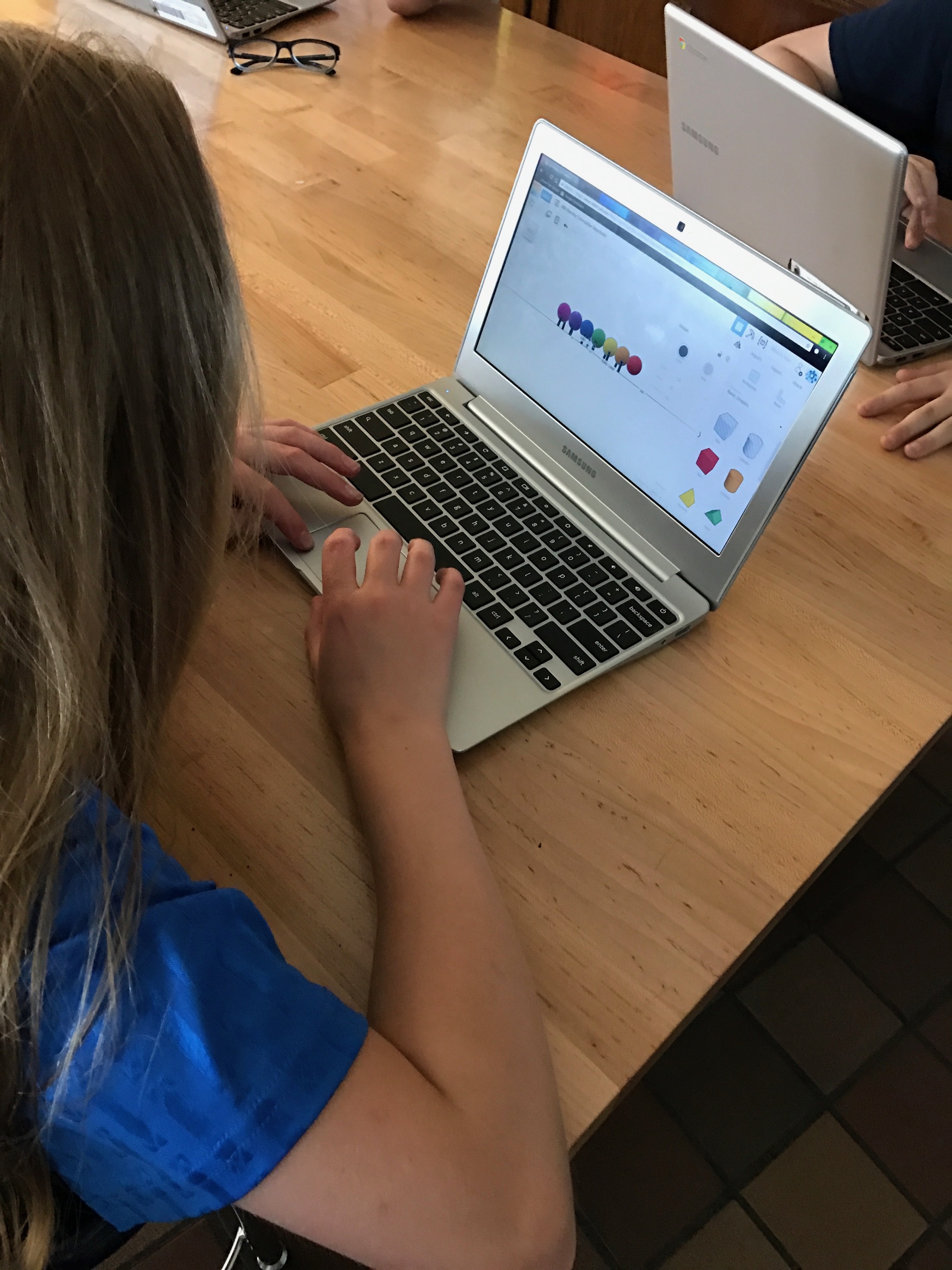
2 Day Tinkercad
7th grade students worked with the online 3D design platform Tinkercad to create their own prototype to be 3D printed. Students utilized spacial reasoning skills working on a 2 dimensional surface to create 3 dimensional forms, while also considering perspective and scale.
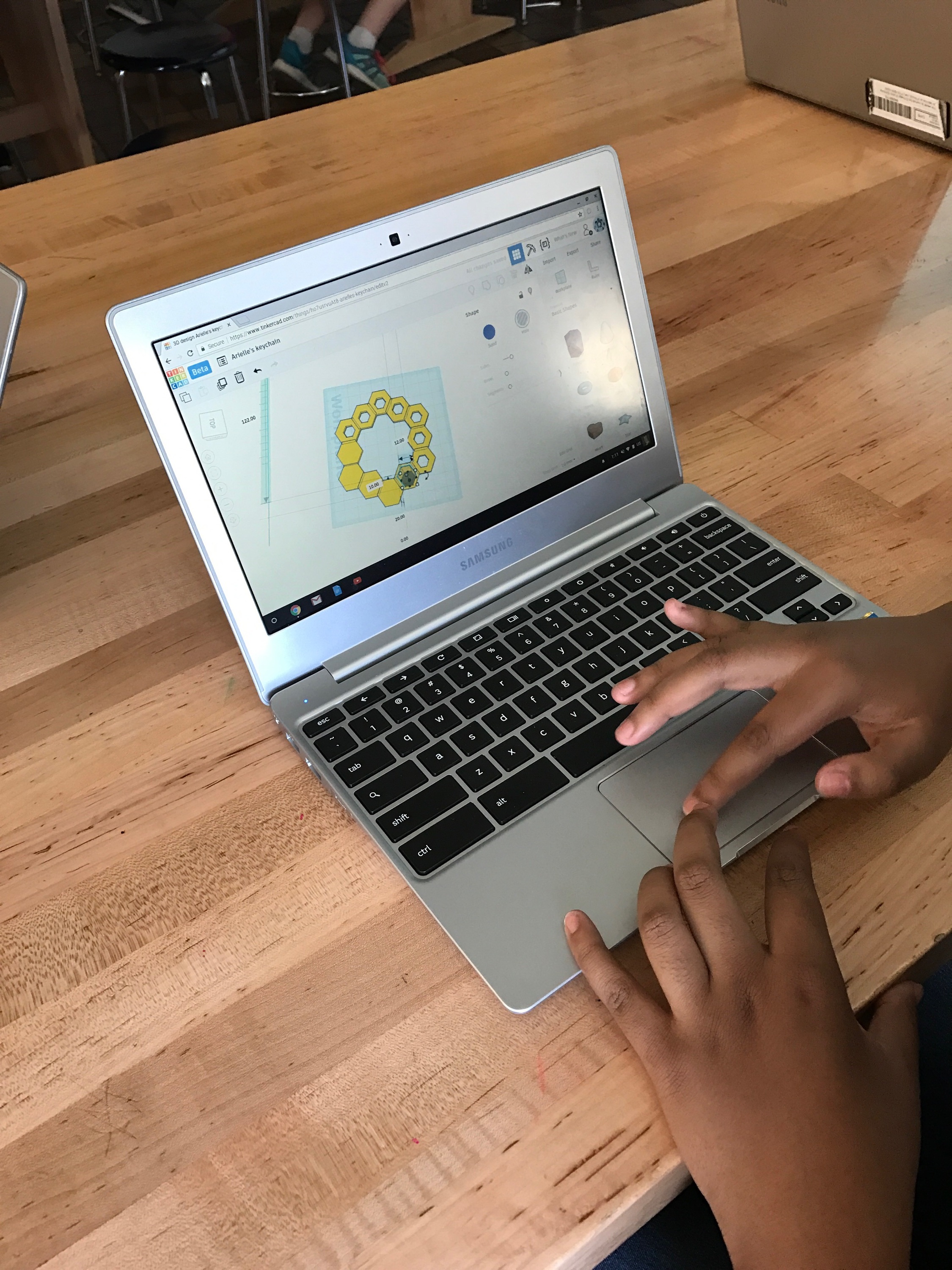
2 Day Tinkercad
7th grade students worked with the online 3D design platform Tinkercad to create their own prototype to be 3D printed. Students utilized spacial reasoning skills working on a 2 dimensional surface to create 3 dimensional forms, while also considering perspective and scale.
Here a student shows their understanding of how to create a hole in their form, a requirement for the project.
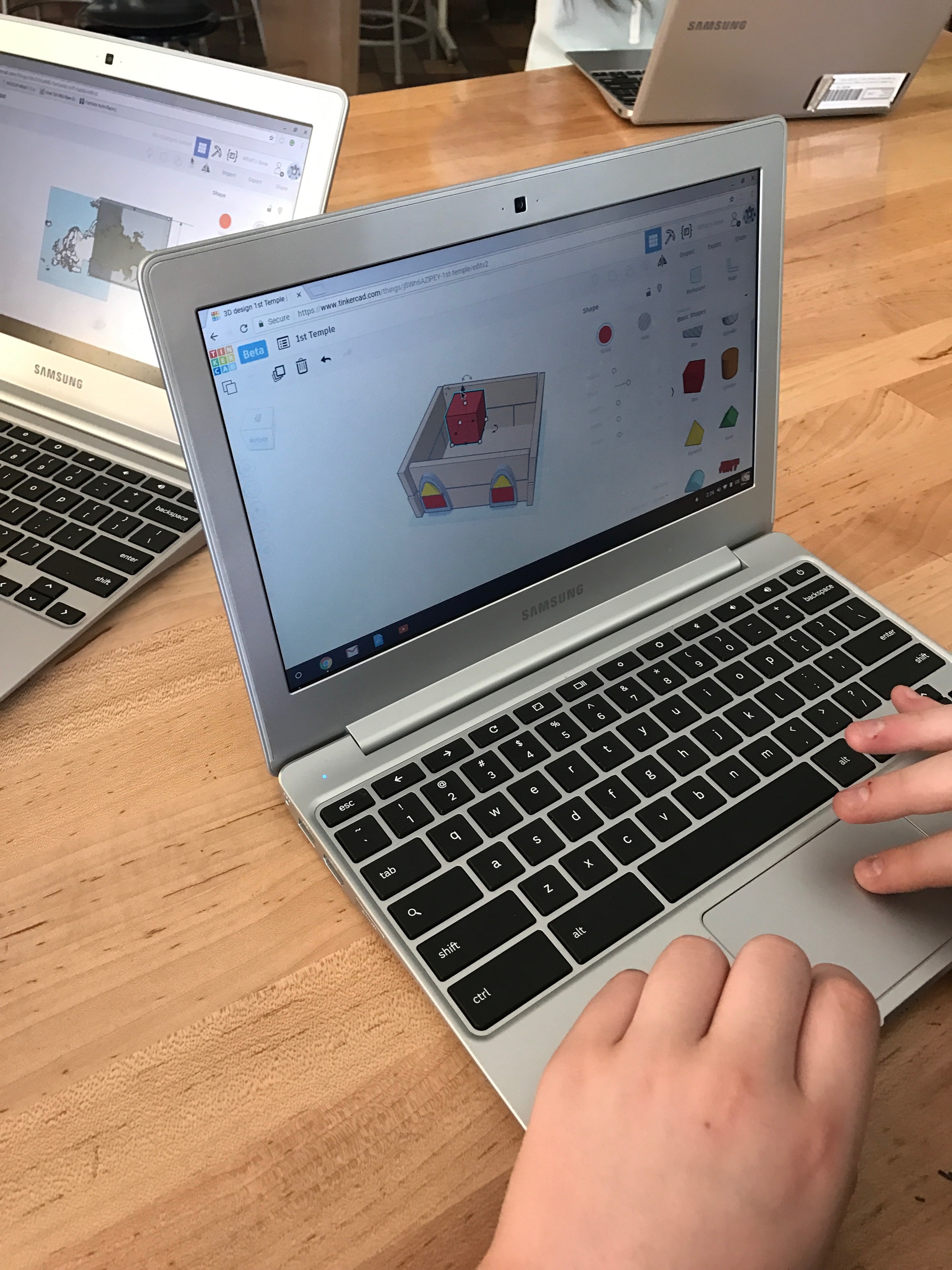
2 Day Tinkercad
7th grade students worked with the online 3D design platform Tinkercad to create their own prototype to be 3D printed. Students utilized spacial reasoning skills working on a 2 dimensional surface to create 3 dimensional forms, while also considering perspective and scale.

2 Day Tinkercad
7th grade students worked with the online 3D design platform Tinkercad to create their own prototype to be 3D printed. Students utilized spacial reasoning skills working on a 2 dimensional surface to create 3 dimensional forms, while also considering perspective and scale.
Requirements:
- must contain a hole
- must be a 3 dimensional form
- must fit within 100 x 100 x 100 mm

2 Day Tinkercad
7th grade students worked with the online 3D design platform Tinkercad to create their own prototype to be 3D printed. Students utilized spacial reasoning skills working on a 2 dimensional surface to create 3 dimensional forms, while also considering perspective and scale.
Requirements:
- must contain a hole
- must be a 3 dimensional form
- must fit within 100 x 100 x 100 mm

2 Day Tinkercad
7th grade students worked with the online 3D design platform Tinkercad to create their own prototype to be 3D printed. Students utilized spacial reasoning skills working on a 2 dimensional surface to create 3 dimensional forms, while also considering perspective and scale.
Requirements:
- must contain a hole
- must be a 3 dimensional form
- must fit within 100 x 100 x 100 mm

2 Day Tinkercad
7th grade students worked with the online 3D design platform Tinkercad to create their own prototype to be 3D printed. Students utilized spacial reasoning skills working on a 2 dimensional surface to create 3 dimensional forms, while also considering perspective and scale.
Requirements:
- must contain a hole
- must be a 3 dimensional form
- must fit within 100 x 100 x 100 mm

2 Day Tinkercad
Preparing the file to print with student work scaled and arranged on the bed using XYZware.

2 Day Tinkercad
Student work newly printed with supports.

2 Day Tinkercad
Student work with supports removed.

2 Day Tinkercad
Student work

2 Day Tinkercad
Student work

2 Day Tinkercad
Student work




















































































